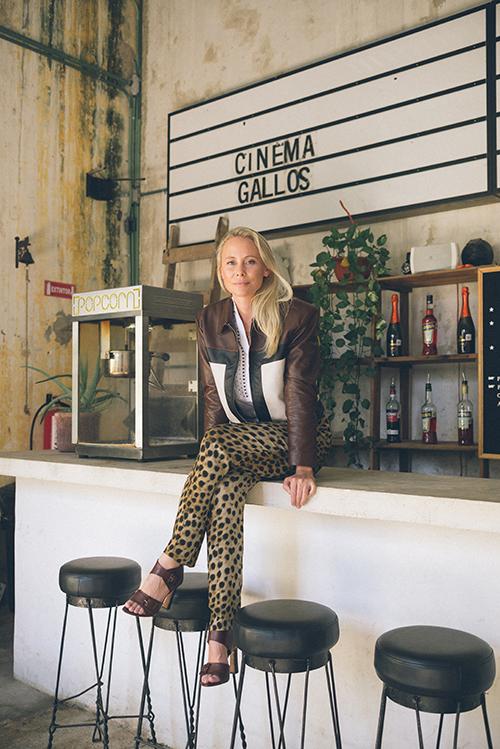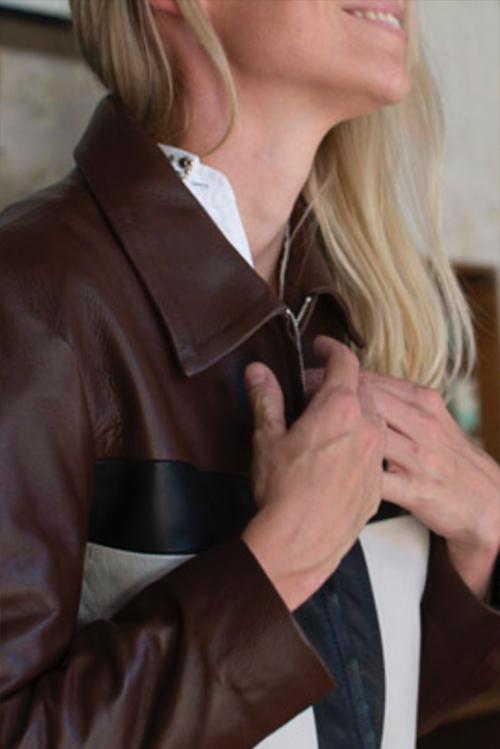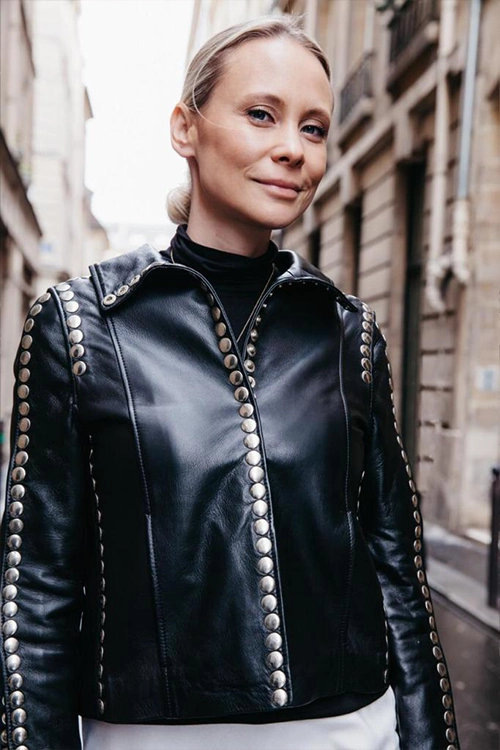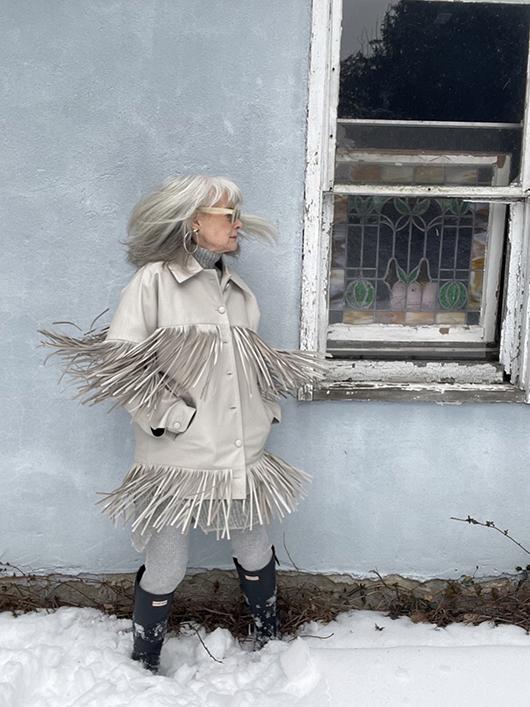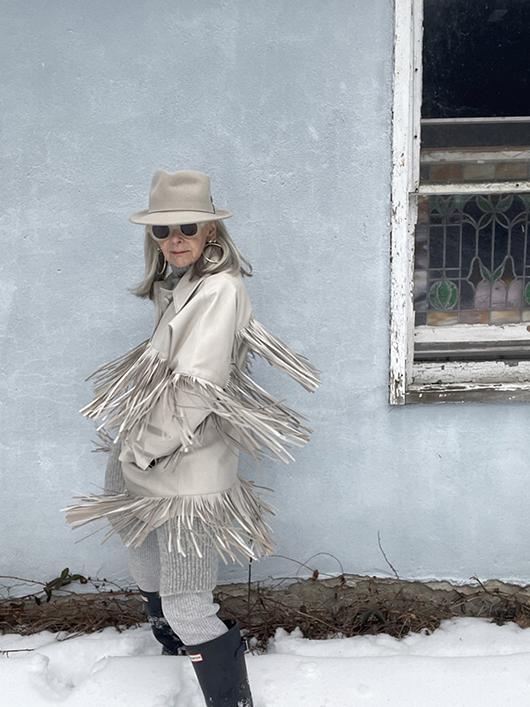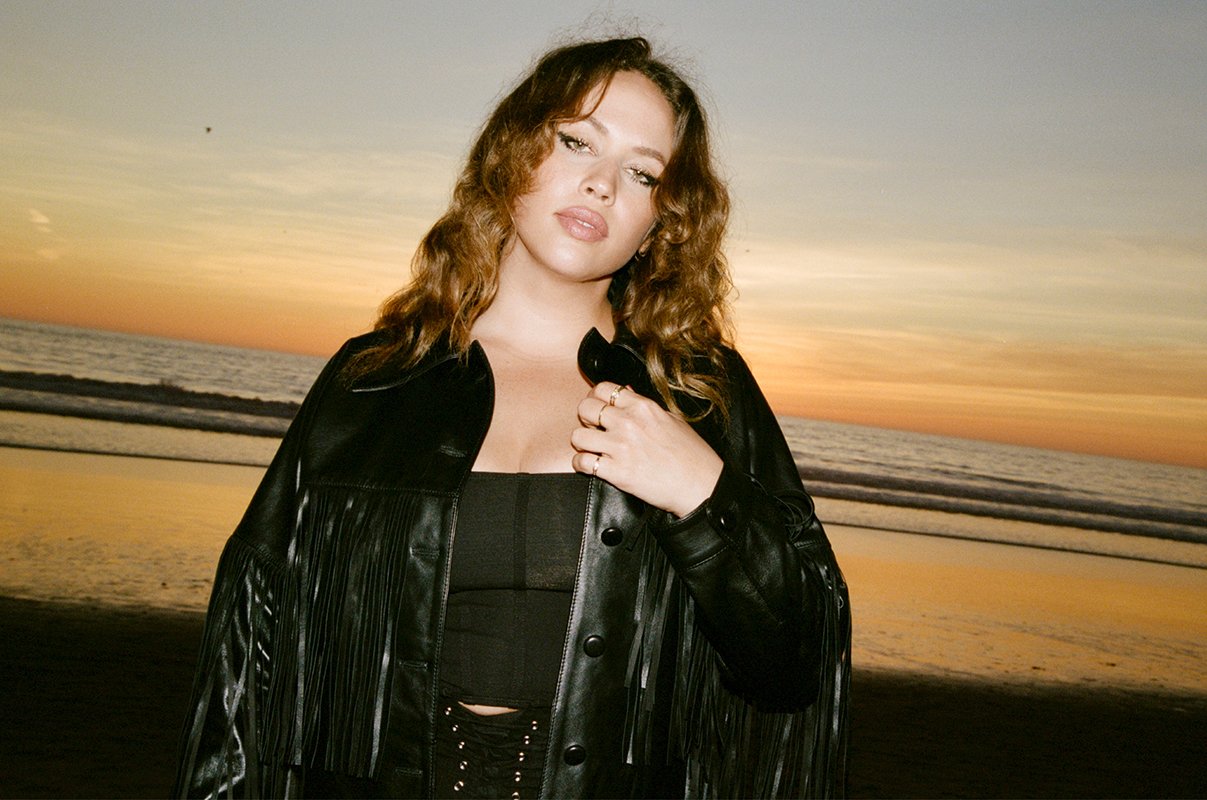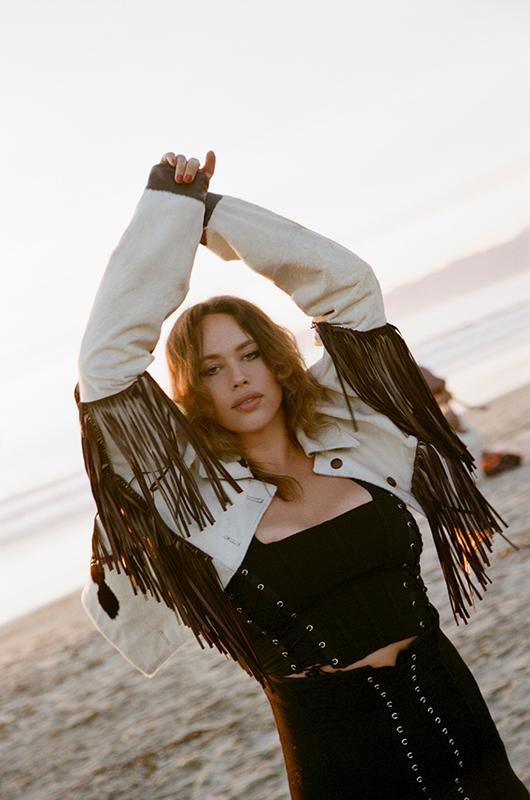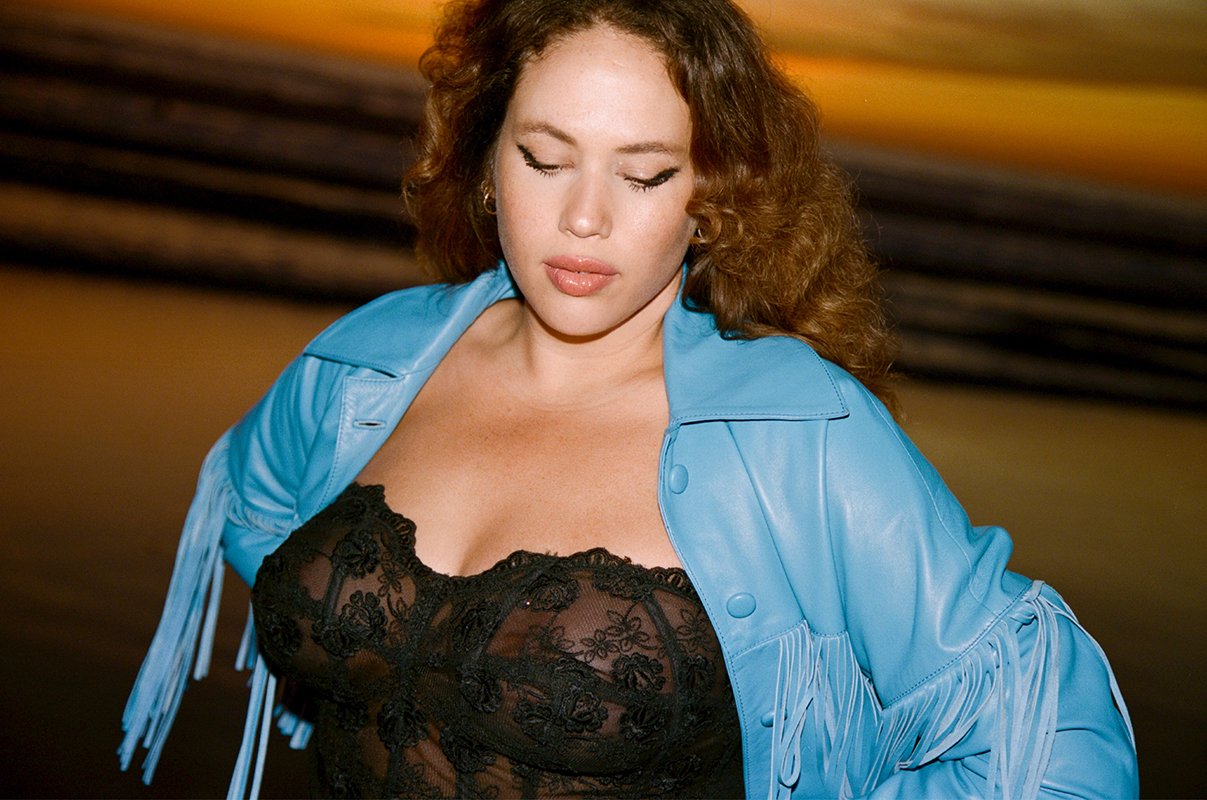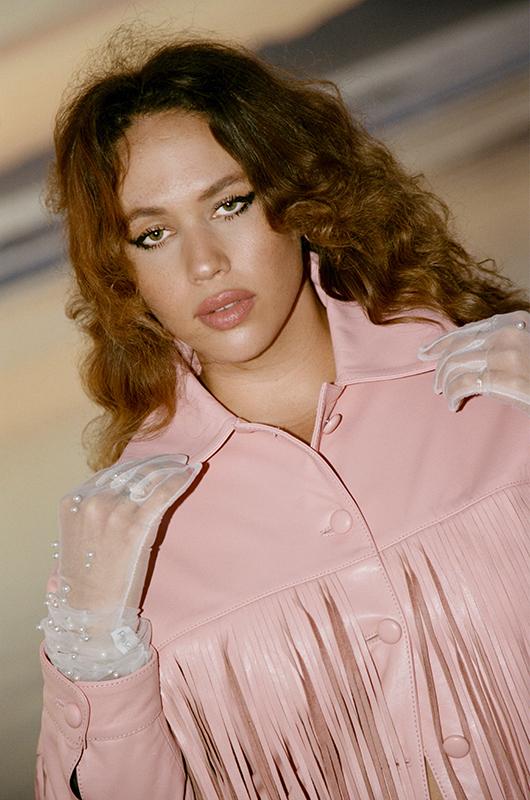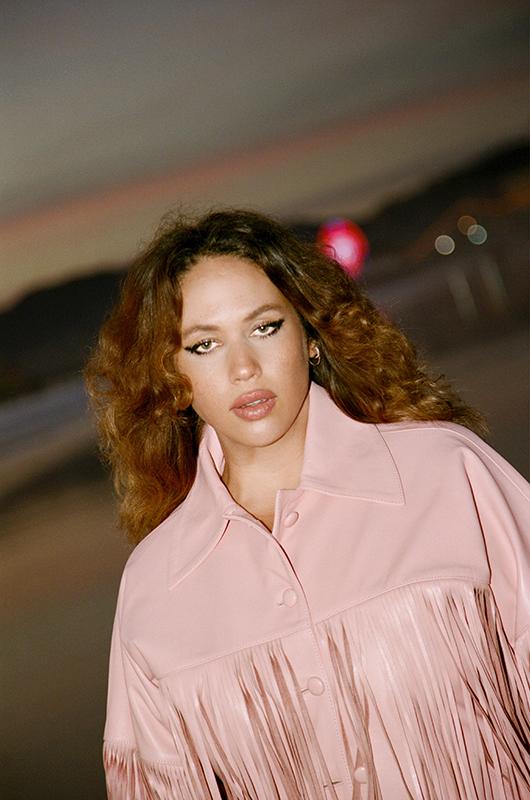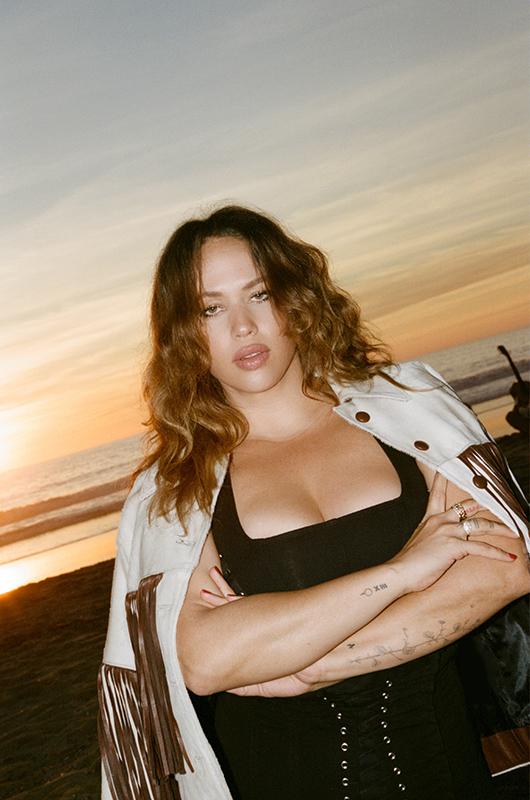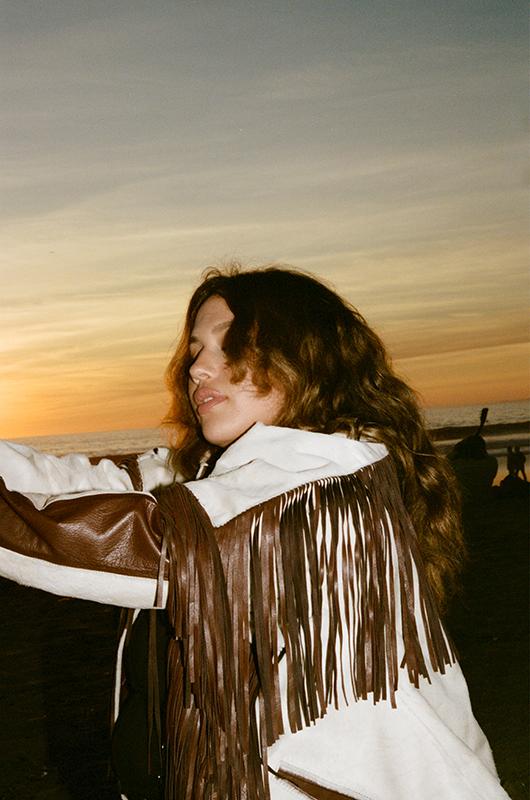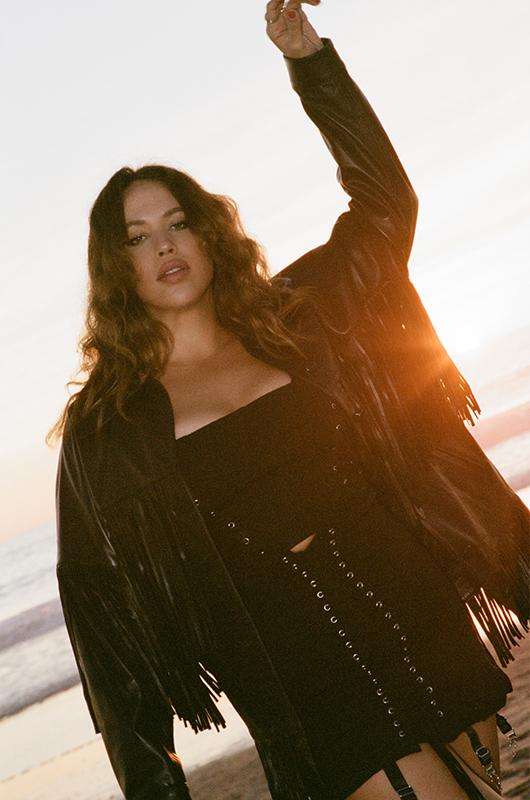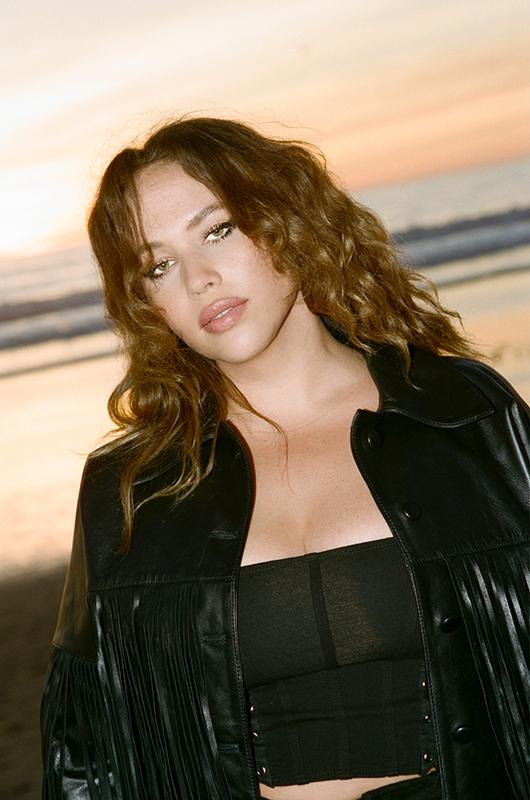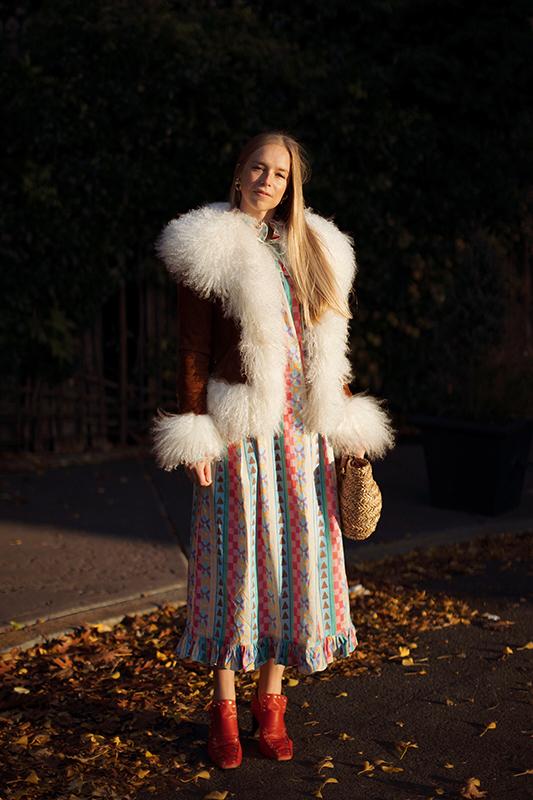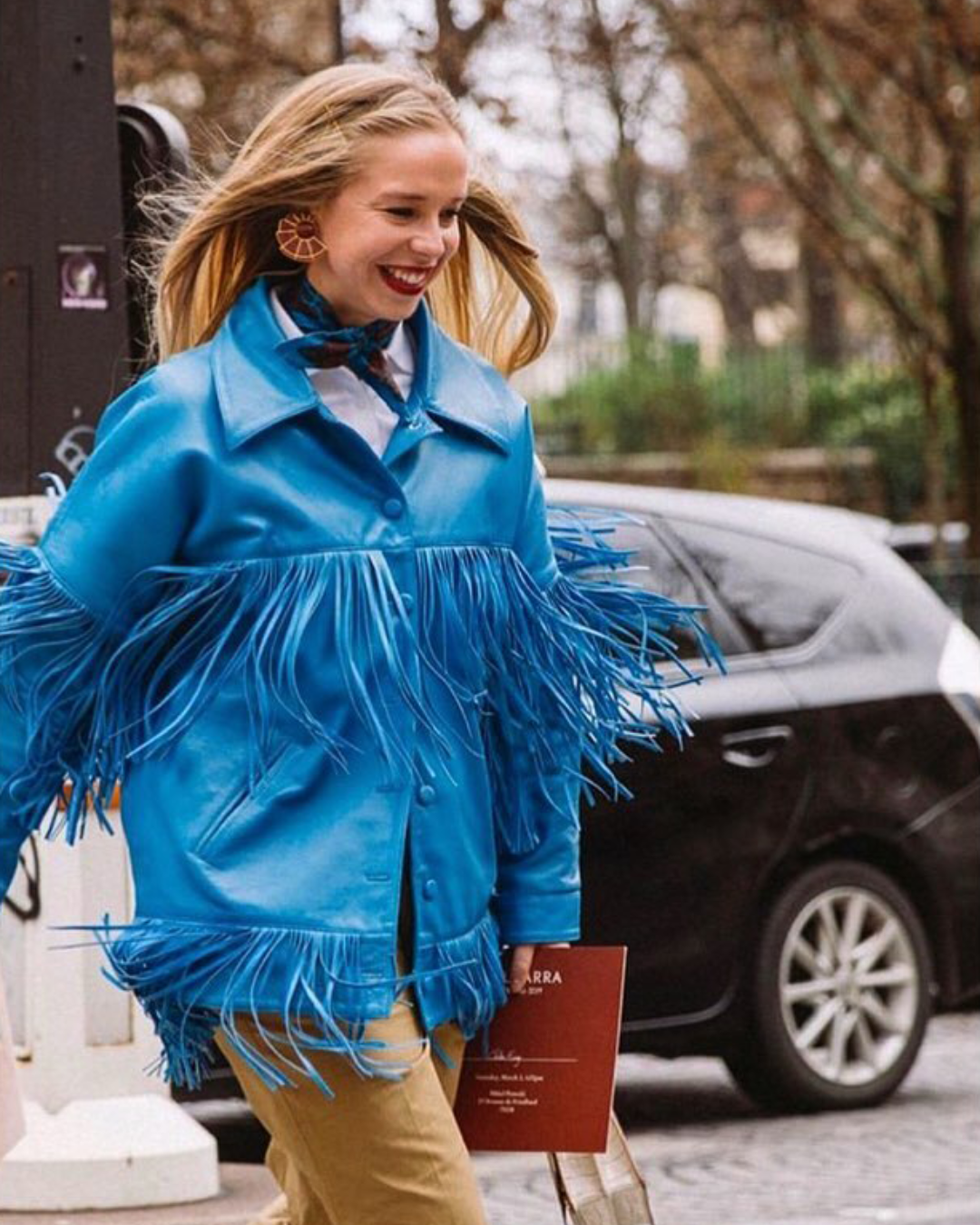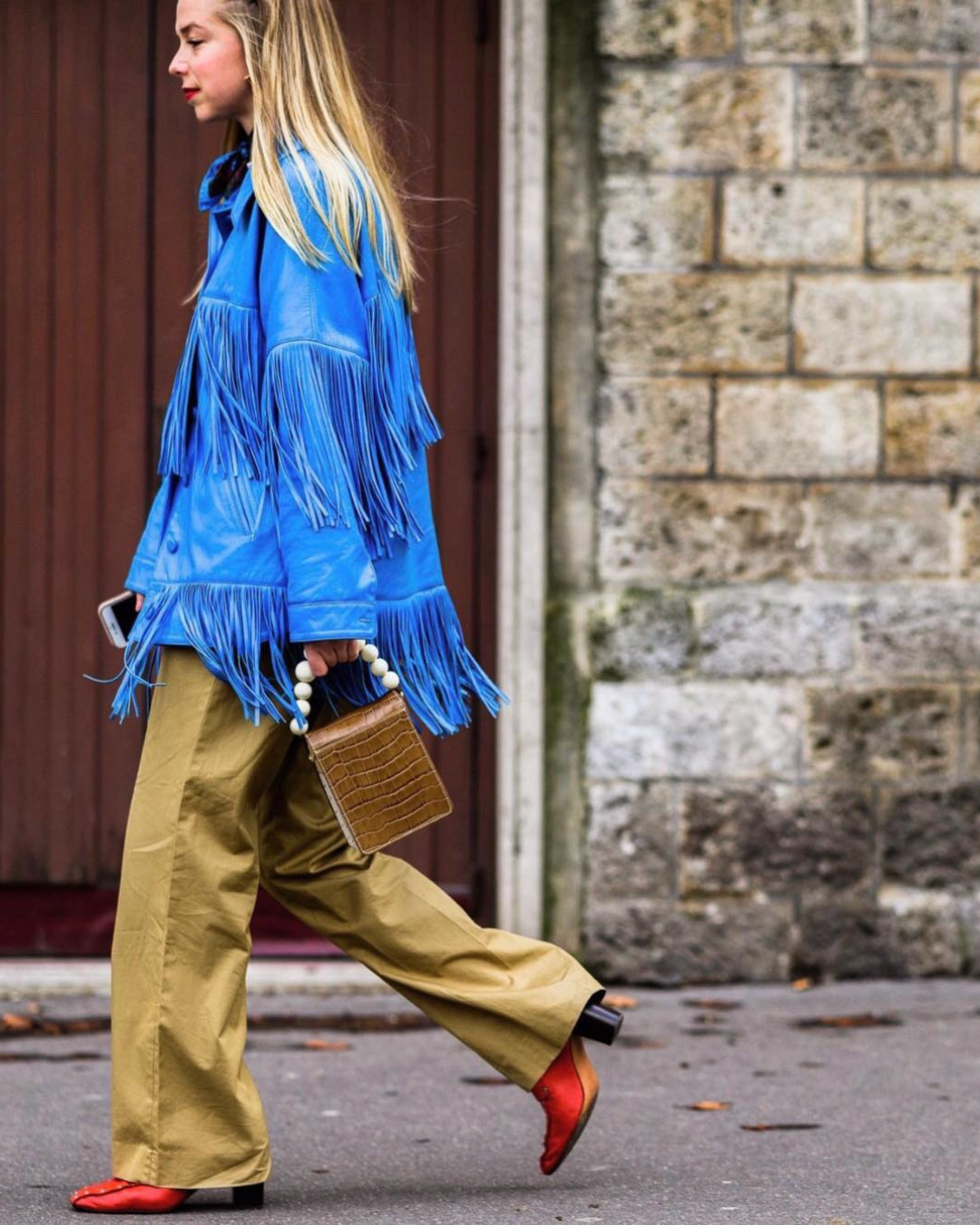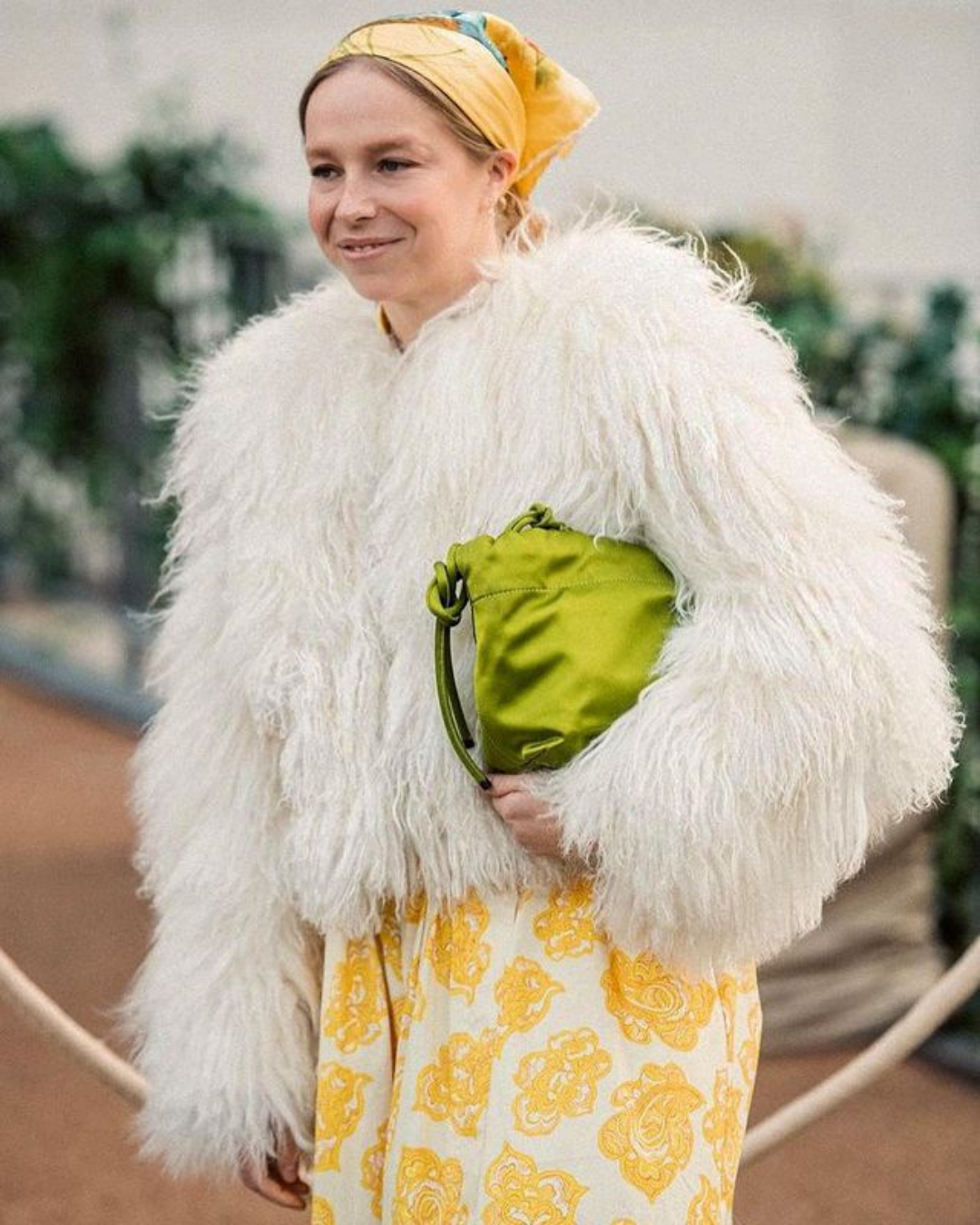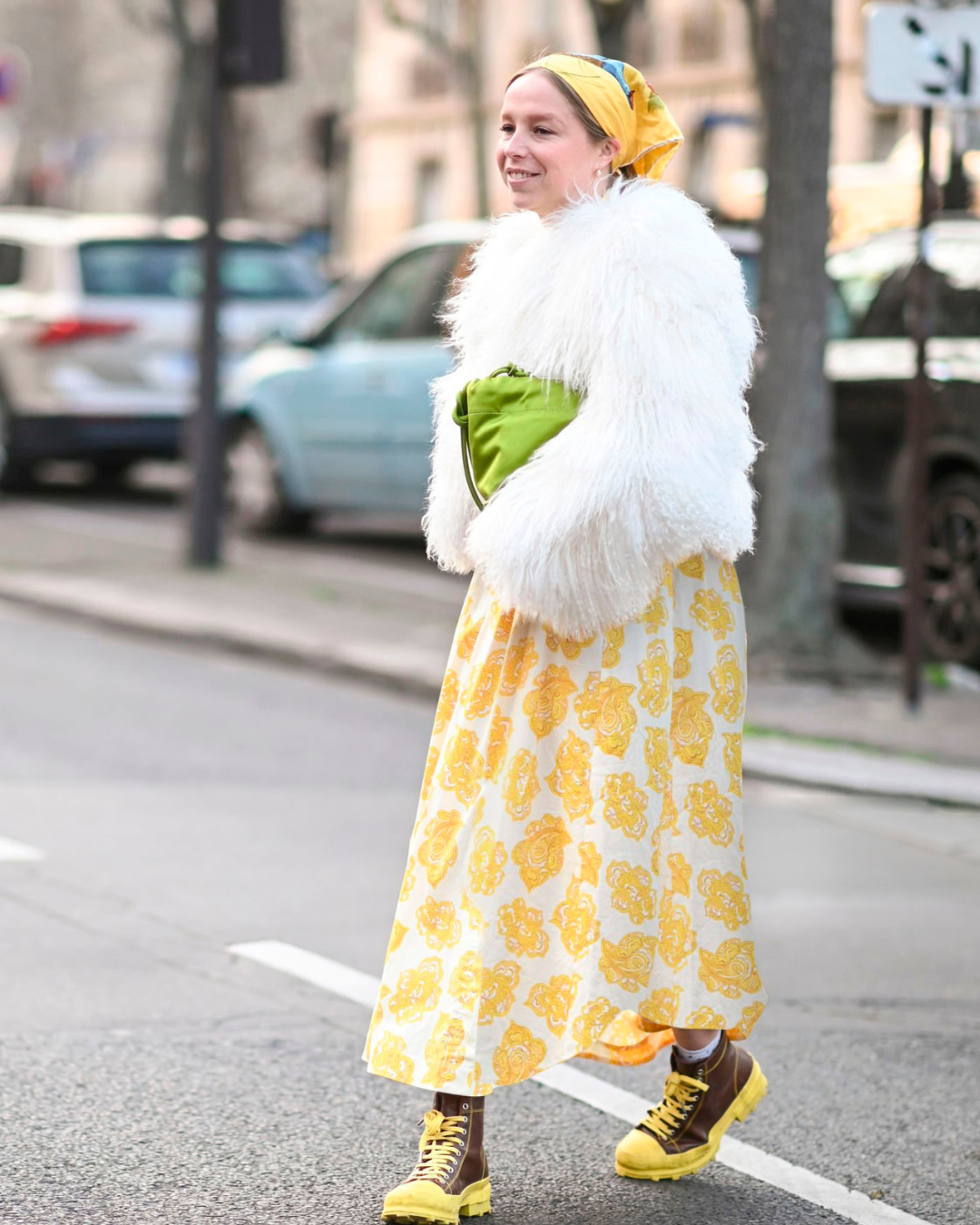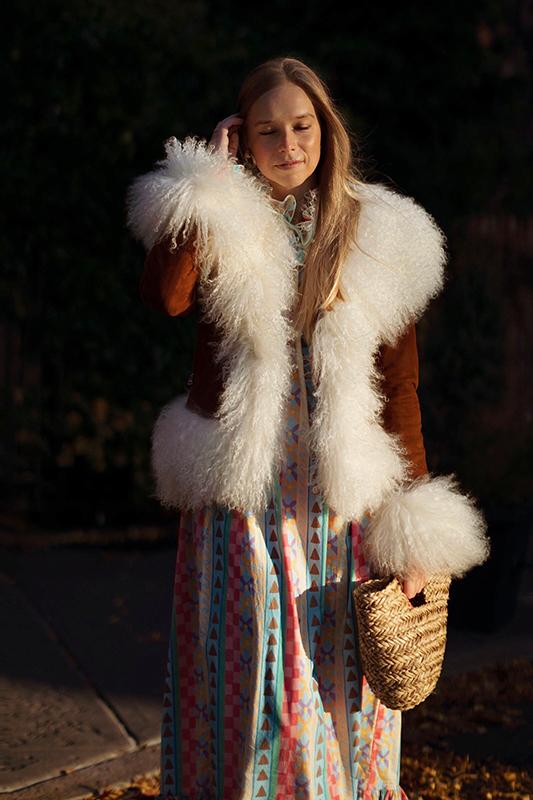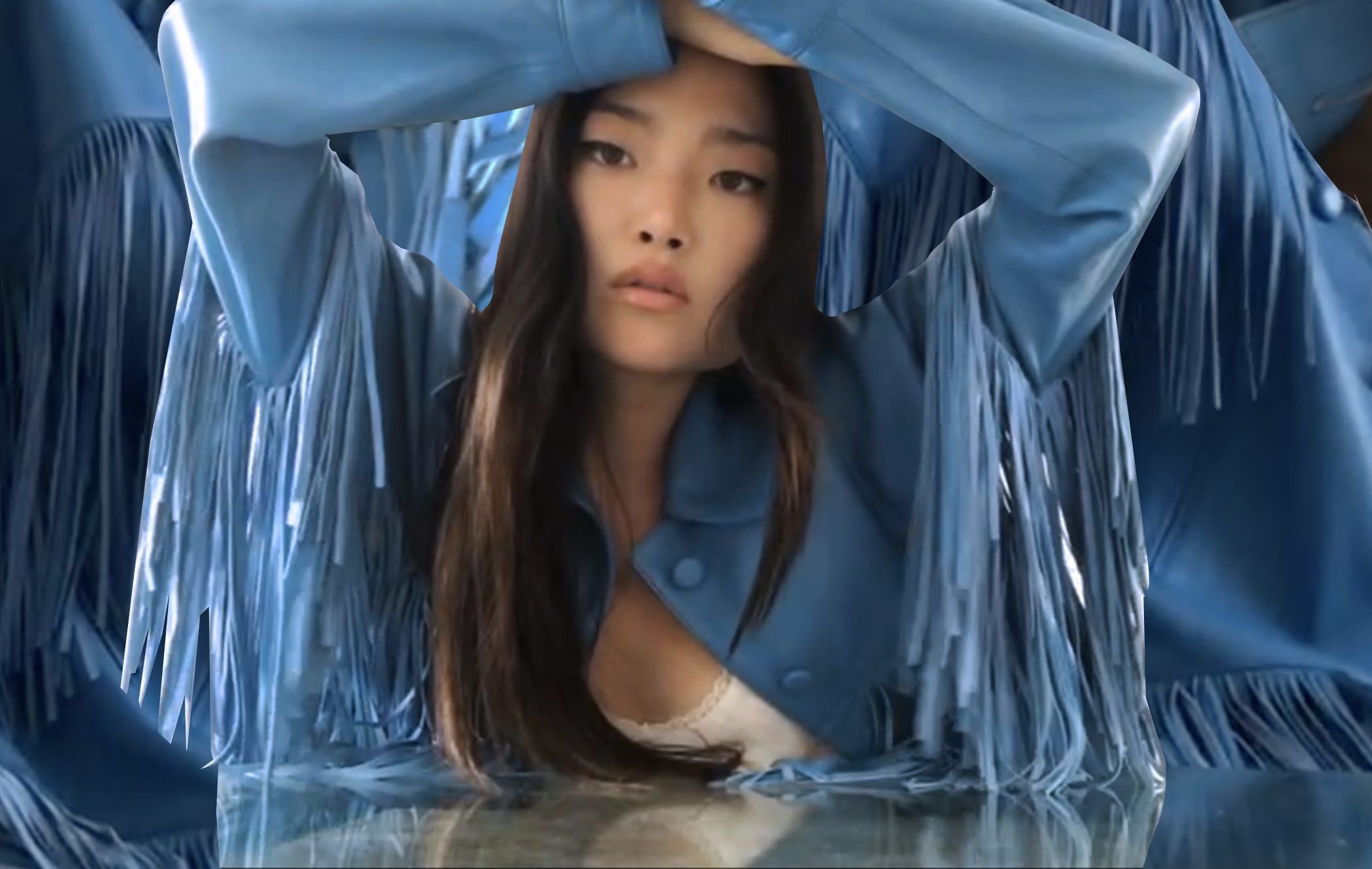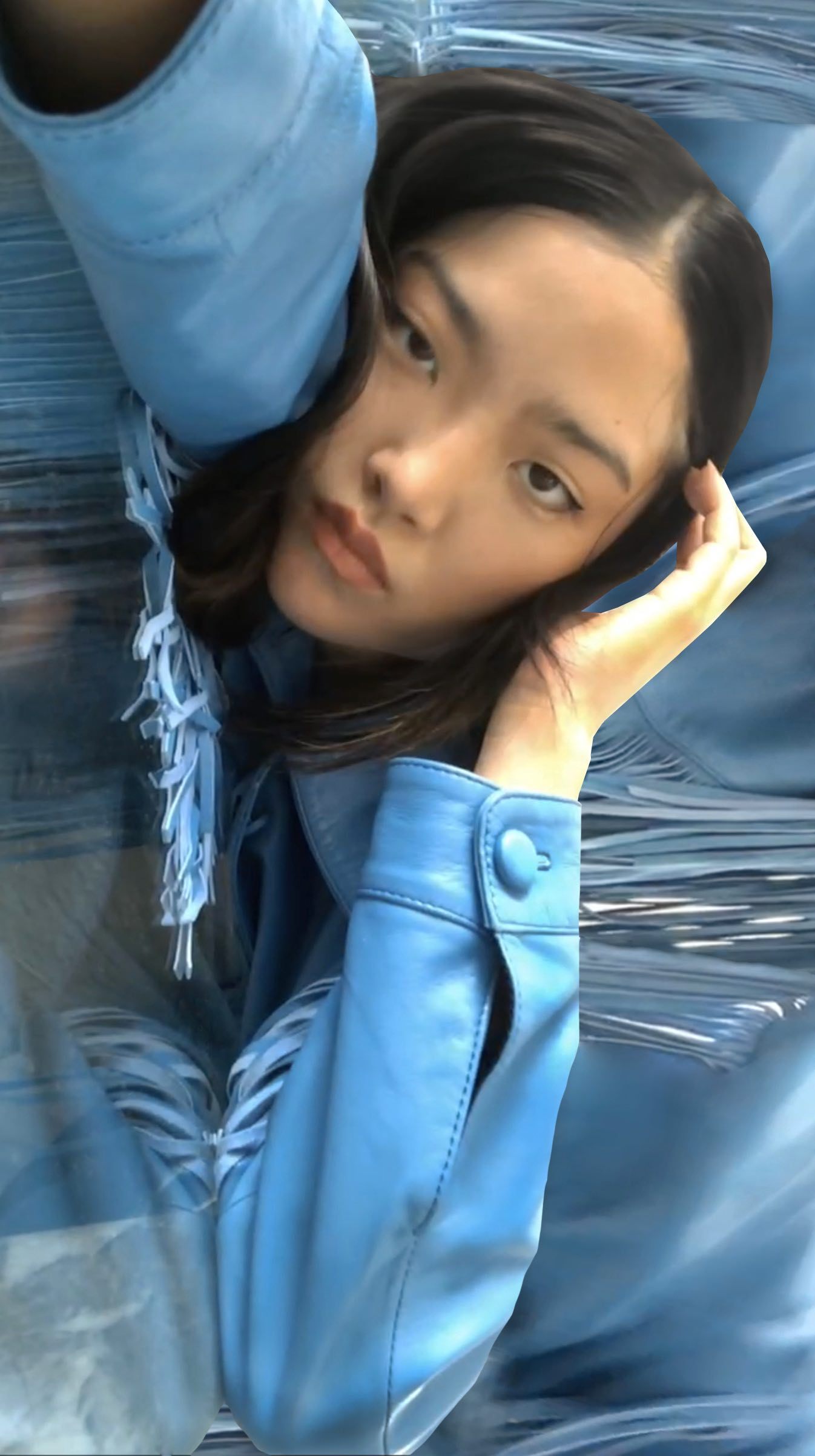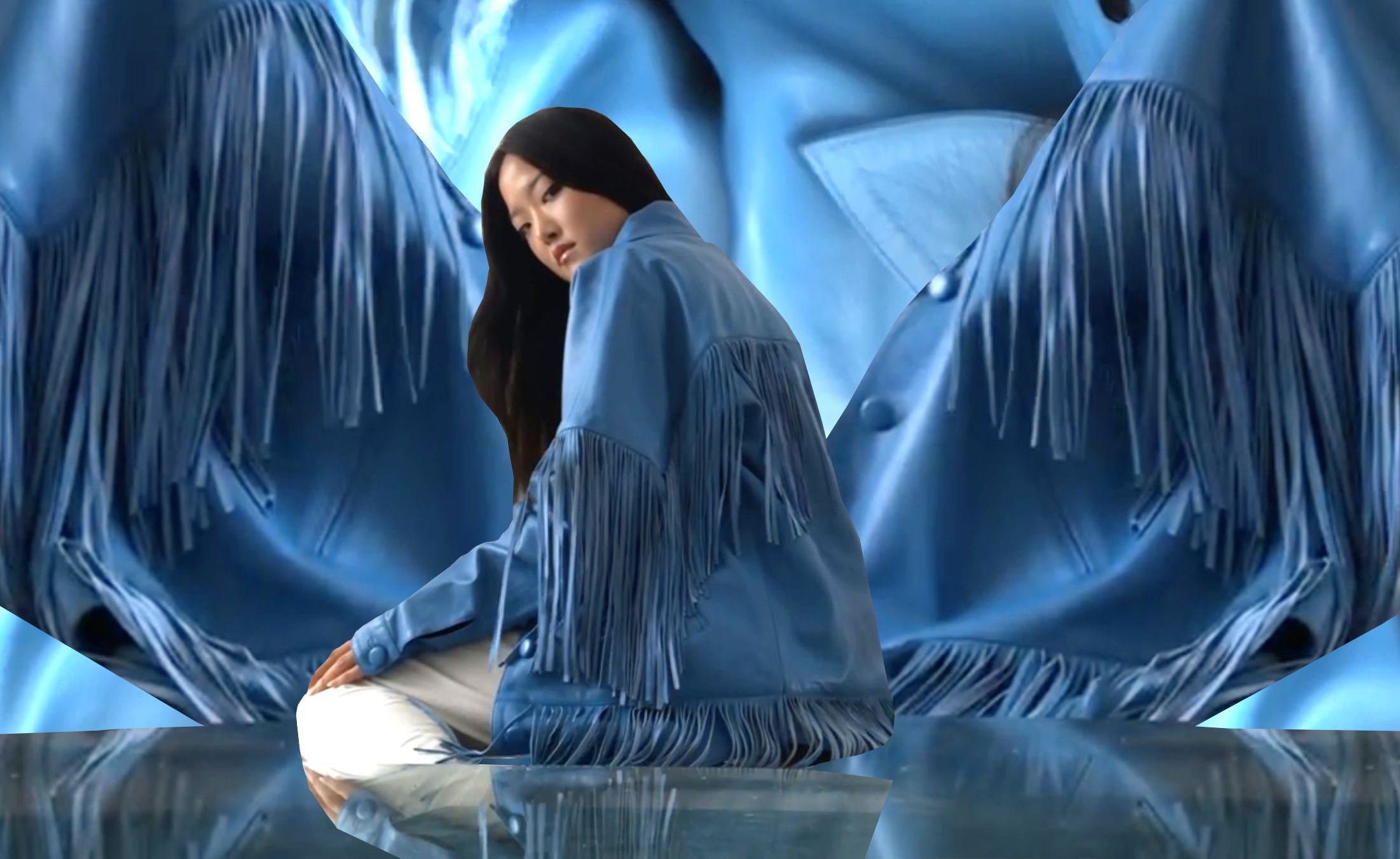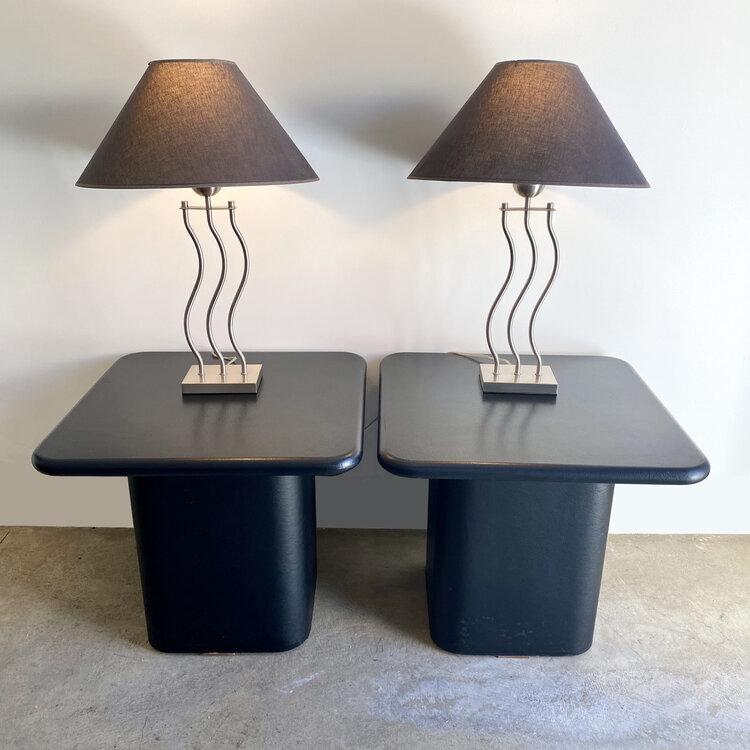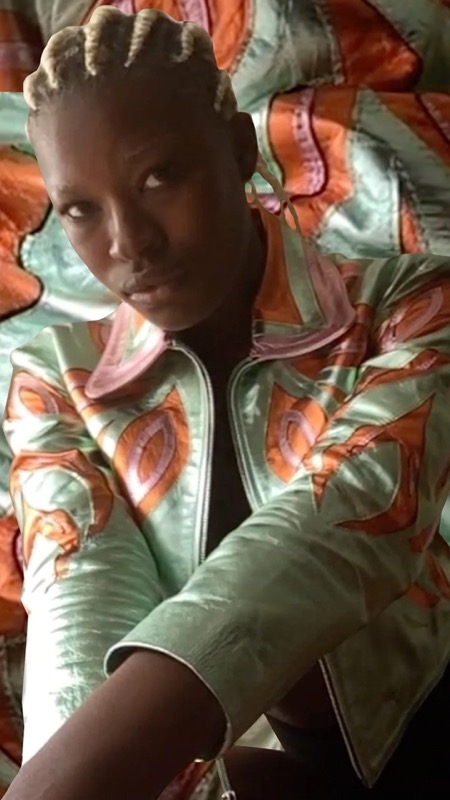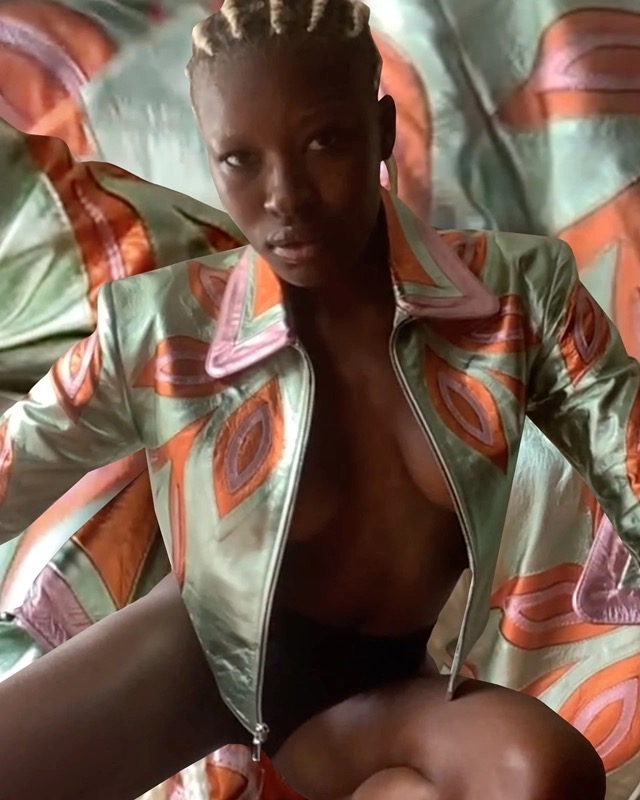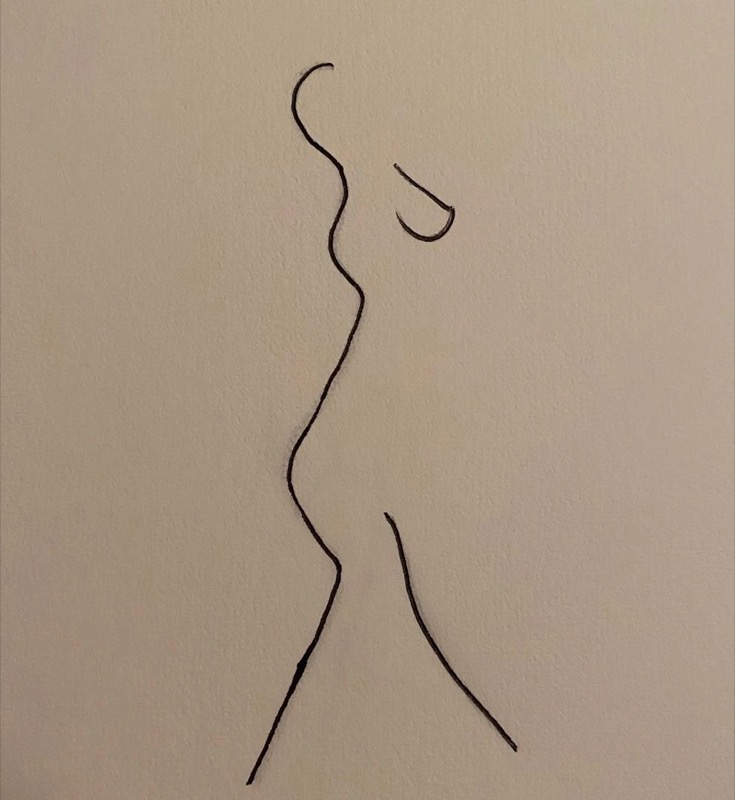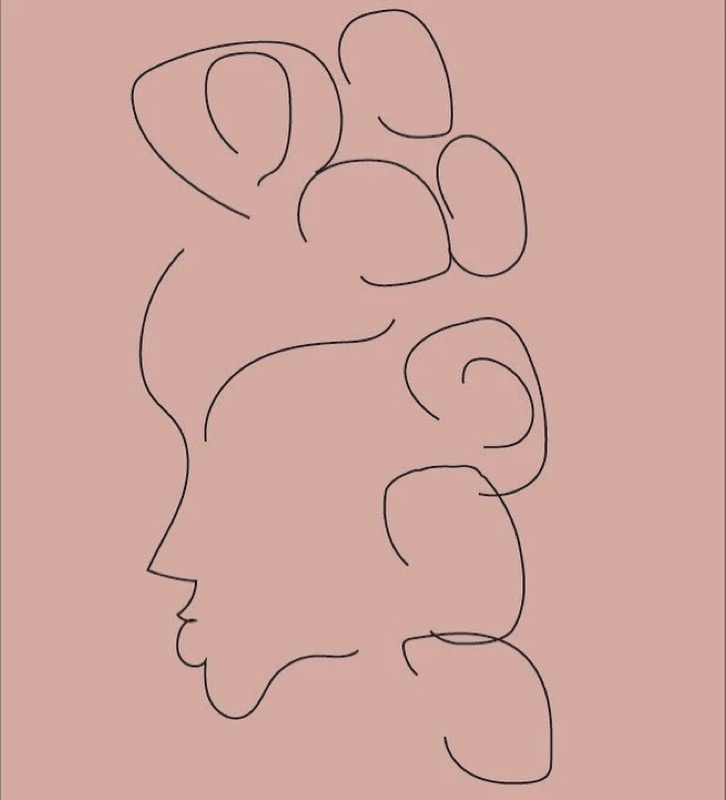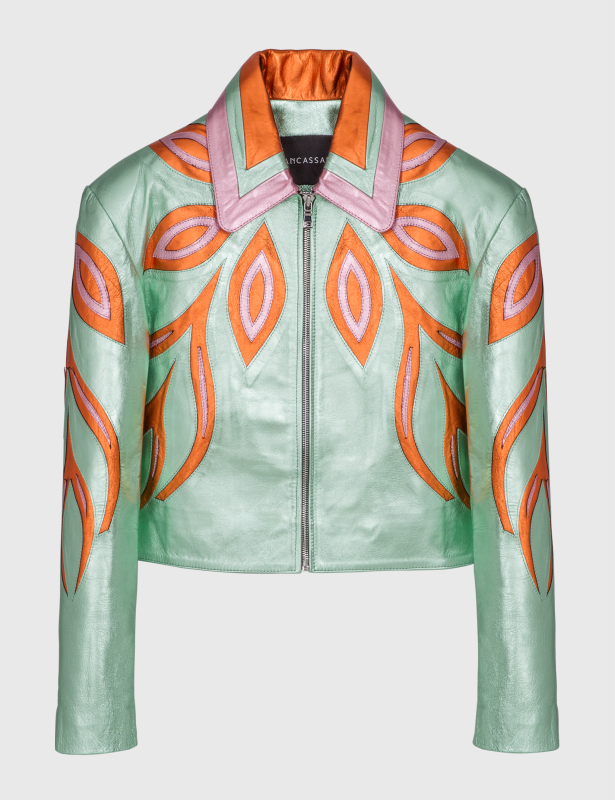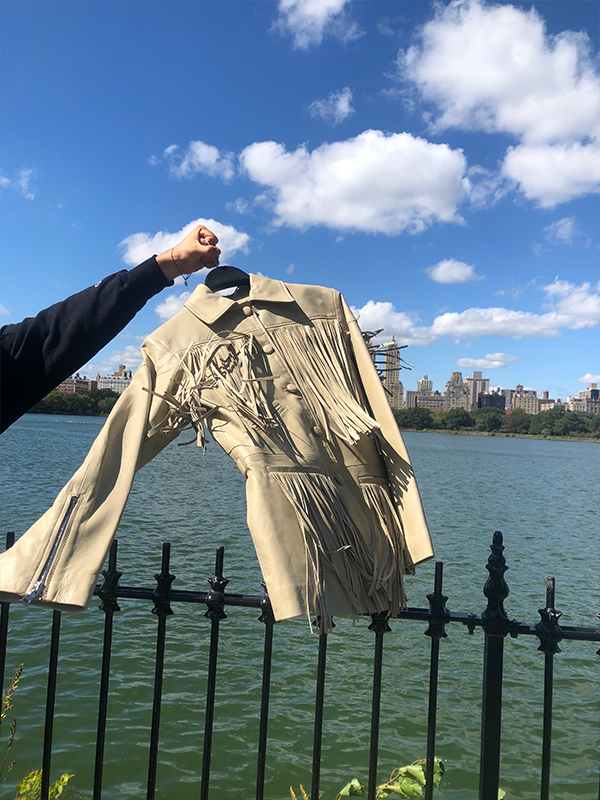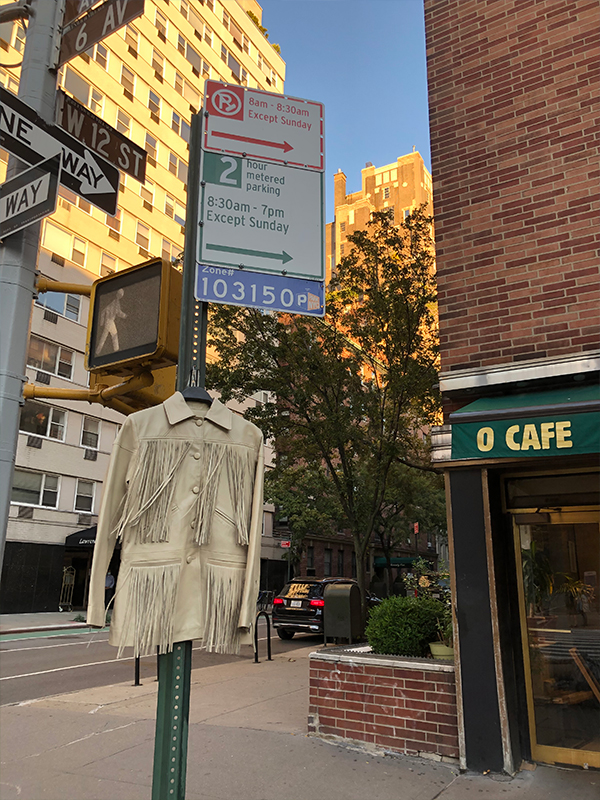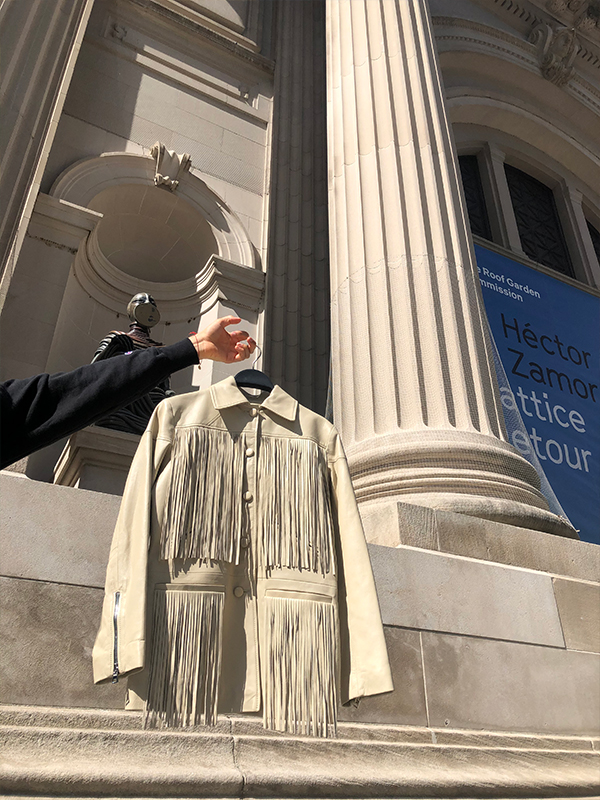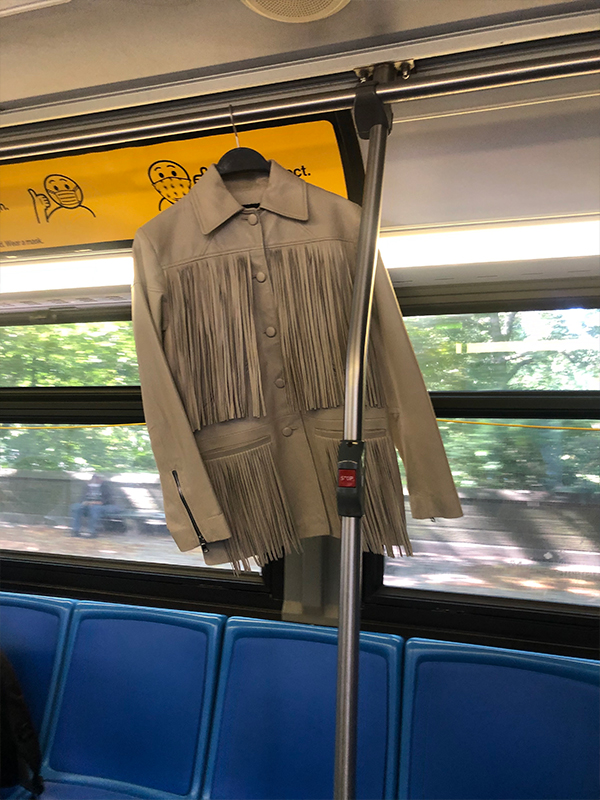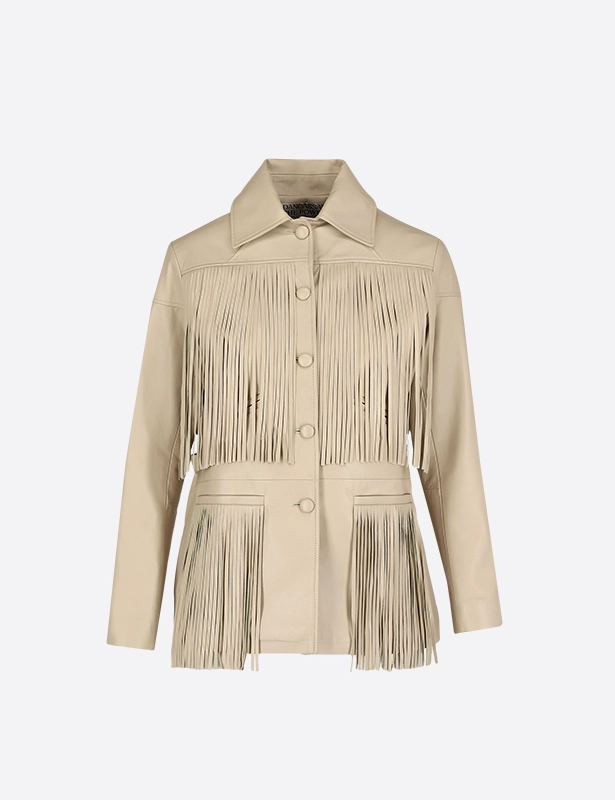
DANCASSAB
VOICES
PAMELA
TICK
Words: Pamela Tick, Interview: Kristom Parson
Pamela Tick, New York-based DJ, model, and eternally positive thinker, spoke to us about her personal style, making dreams come true, and her immense love for human connection.
After enduring the histrionics of east coast weather for over a decade, it is still astonishing to witness the first thunderstorm of the year. On a Mid-April afternoon, this one was complete with gale-force winds and marble-sized hail, which bounced from cherry blossoms onto car hoods while garnishing the plates of sidewalk lunch-goers. Thankfully, it was followed promptly by radiant sunshine and blue skies – all in an (eight hour) day’s work. As city-dwellers, we tend to have amnesia when it comes to our scale in nature until a humbling series of events like this come around again. We tend to find comfort ensconced in conducting the orchestra of our own thoughts, busy directing the theatrics of unknowns to remember or notice when the biggest comedian in the solar system, the sun, pops back in for a quick finale after a chaotic storm.
It is safe to say most people on earth have heard of New York City, and chances are they have some understanding of its grandeur and madness, both found in its iconic landscape and characters personified in the media alike. Indeed, there are a few “theories” about what New Yorkers are like. While some of them may prove true from personal experience or a cousin’s sister who visited that one time, the only sure bet about the people of New York City is that just like the weather, they, too, will always surprise you.
I first met Pamela Tick in 2015. At the time, she was well on her way down a multi-hyphenate creative path, having already assumed the roles of stylist, model, and brand muse for emerging cool-girl brands from far and wide. Her personal style embraces a beachy boho-meets-gamine energy sitting somewhere along the intersection of Birkin, Bardot, Fawcett, and 90s Moss. Thinking back, it took mere seconds to discover that while she is objectively gorgeous, what really stuck with me was her character. This anomaly of a New Yorker with long, blonde locks and a golden tan just breezed in with bubbling energy and a genuine warmth that was undeniably contagious. If you presume encountering this type of personality here is somewhat atypical, slightly off-brand, or even potentially extinct by some standards, you are not wrong. But for someone who naturally lives by the ‘work hard and be nice to people’ mindset, she proves it possible to unsubscribe to this stereotype, revealing that “…the culture, the energy, it’s different every day. You can be whoever you want in New York. No one cares. As long as you are confident, it’s your world!”
Being the renaissance woman Pamela is with her good-hearted nature and knack for bringing sunshine to any room is what sets her apart and makes her so sought after – particularly a bonus for DJing. As she recalls, “When I moved to NY and wanted to pursue all the lanes that I love; fashion, music, and lifestyle entertainment – DJing encompassed them all.” Naming Carl Cox, DJ AM, and Funkmaster Flex as influential pioneers of the New York DJ scene, she also recalls a genre that inspired her from formative years, “My dad would always play best of the ’50s as well as lots of Motown. I am always inspired to find remixes that tie in my childhood tunes with current vibes.”
Perhaps it’s too obvious, or not complicated enough for our overloaded, modern minds, but Pamela’s self-prescribed mantra, leading with kindness, is a valuable reminder often taken for granted. But when paired with patience and grace, kindness allows us to show up for ourselves first so we can do the same for others. In her wise words, “We are all human – we can’t ALWAYS 100% of the time be happy. But we can be positive. I feel being positive is the decision you can make based on your feelings. To me, positivity encourages hope and puts out good energy. Why wouldn’t we choose that? Something that has stuck with me forever is ‘you can either make yourself miserable, or you can make yourself happy – the amount of work is the same.’ It’s true.”
What Pamela hopes to be most remembered for is “Making people feel good,” and with our short existence on earth, what is more important than that?
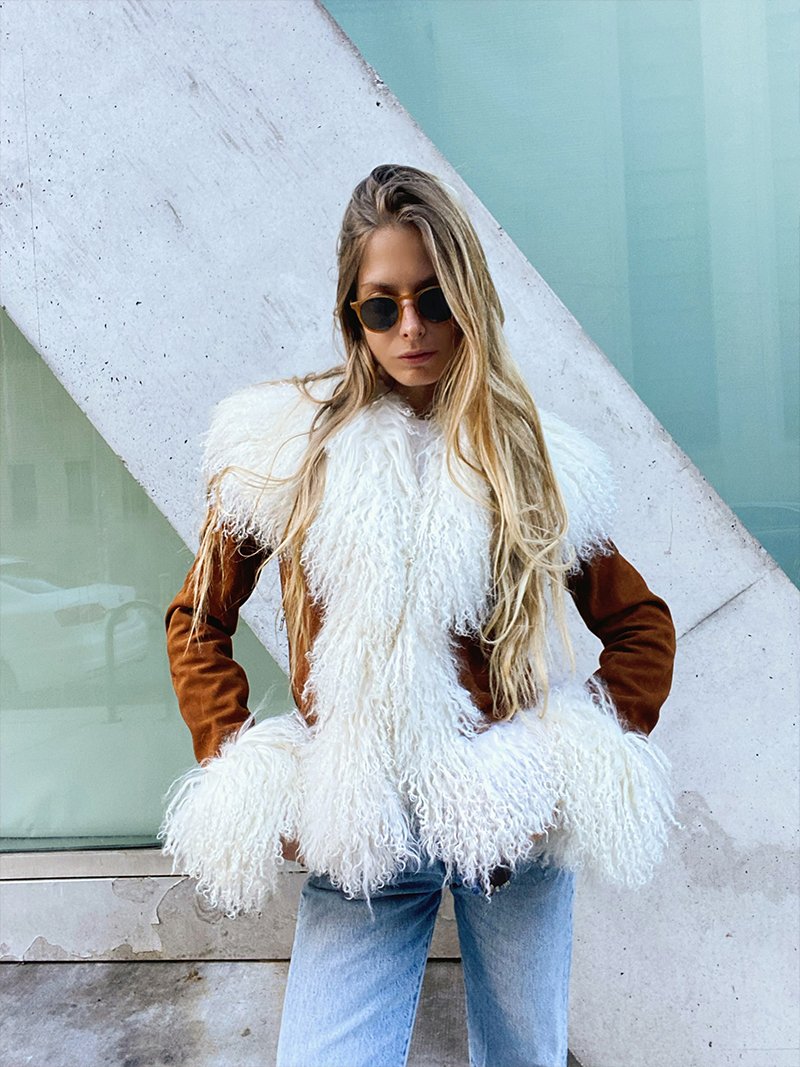
‘ WE ARE ALL HUMAN – WE CAN’T ALWAYS 100% OF THE TIME BE HAPPY. BUT WE CAN BE POSITIVE. I FEEL BEING POSITIVE IS THE DECISION YOU CAN MAKE BASED ON YOUR FEELINGS. TO ME, POSITIVITY ENCOURAGES HOPE AND PUTS OUT GOOD ENERGY. WHY WOULDN’T WE CHOOSE THAT? SOMETHING THAT HAS STUCK WITH ME FOREVER IS “YOU CAN EITHER MAKE YOURSELF MISERABLE, OR YOU CAN MAKE YOURSELF HAPPY – THE AMOUNT OF WORK IS THE SAME.” IT’S TRUE. IN ORDER TO PRESERVE MY POSITIVITY, I TRY TO PUT LIFE INTO PERSPECTIVE AND SHARE QUALITY TIME WITH PEOPLE WHO BRING OUT THE BEST IN ME. ’ — PAMELA TICK.
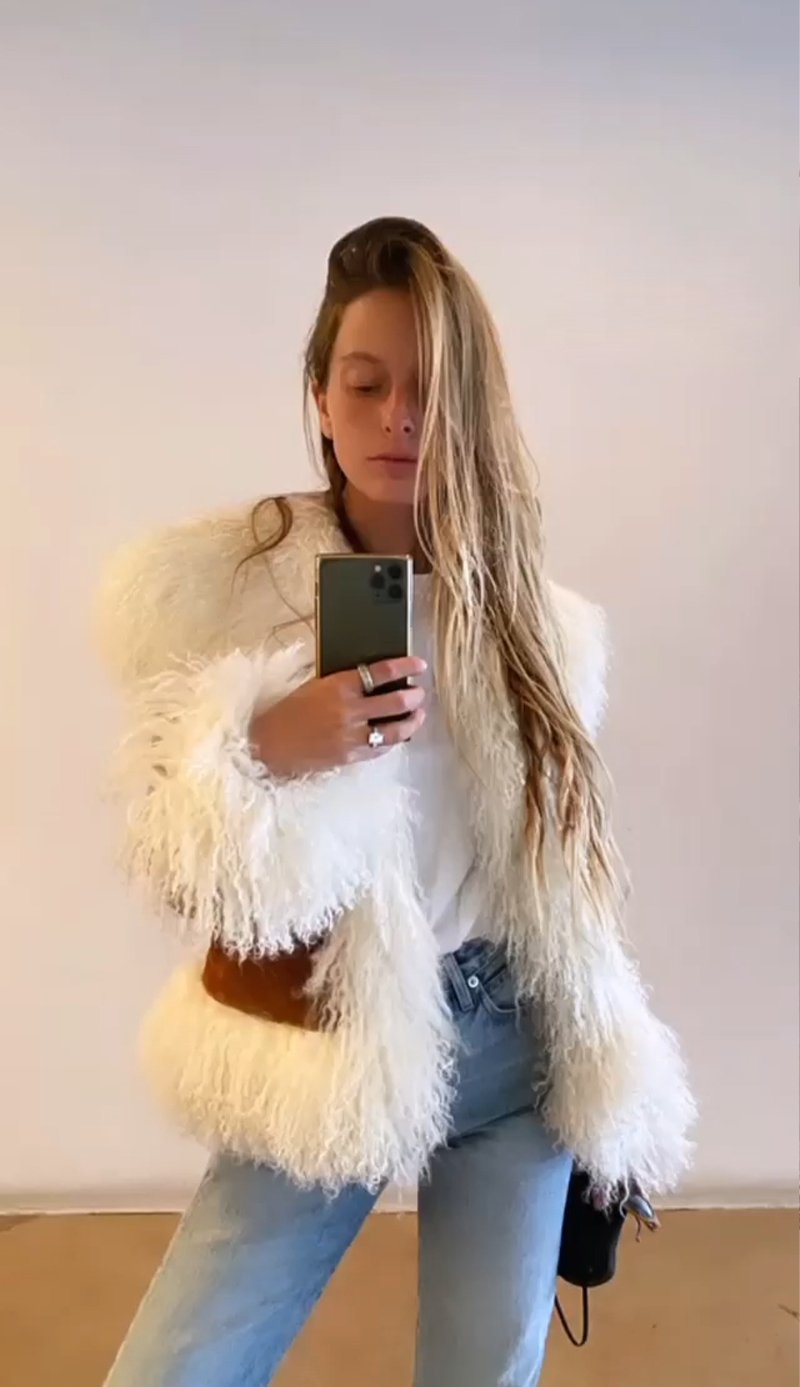
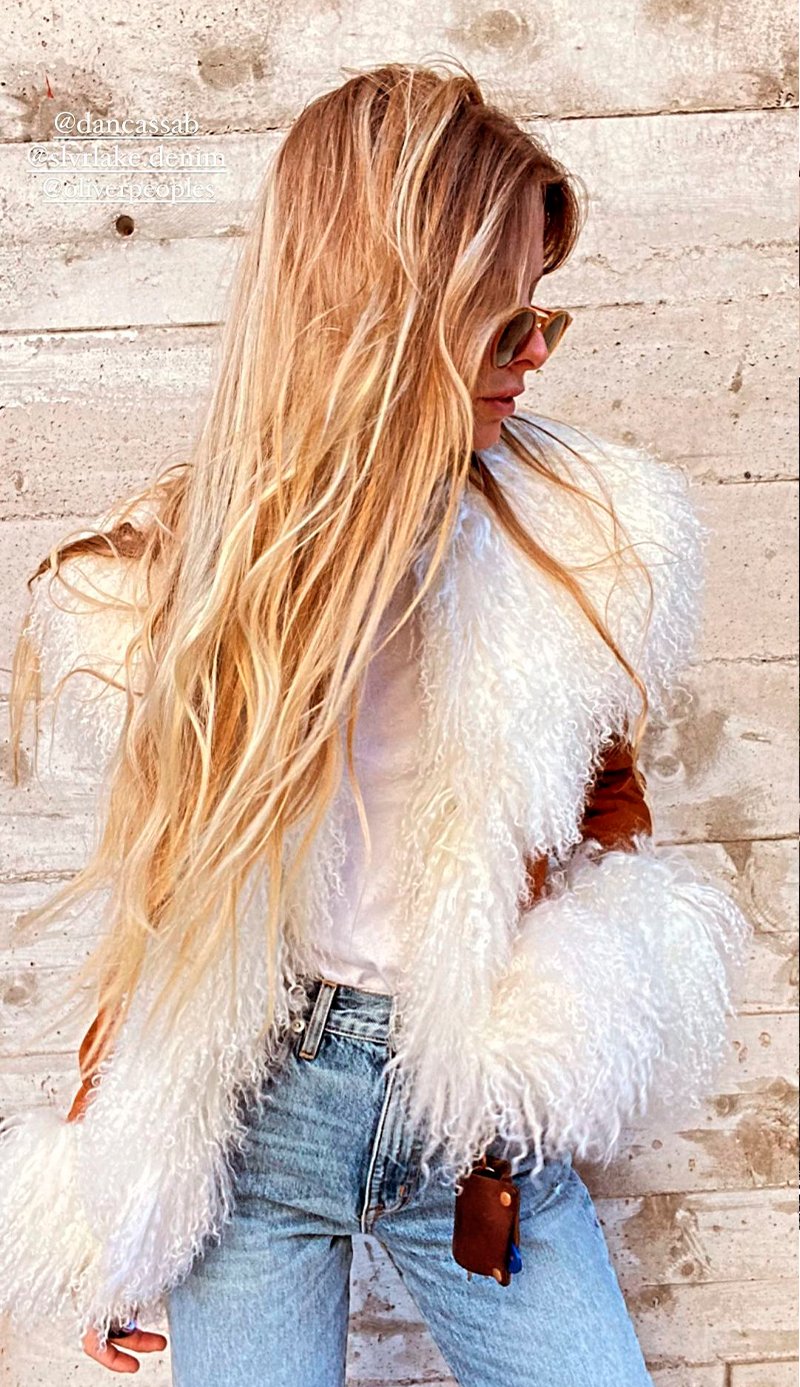
DC: You’re a New Yorker through and through, but with this incredibly warm personality that is so contagious and also a bit atypical of the city stereotype. It’s such genuine, refreshing energy to be around. Is this the general outlook you’ve had on life for as long as you can remember?
PT: I’ve always grown up with the notion “do unto others as you would have them do unto you.” For as long as I can remember, being nice to everyone has always been so important but also natural to/for me. In my favorite tips of life, “Be Kind” is at the top. And in New York, it’s especially refreshing and doesn’t go unnoticed.
DC: Are there times when it’s challenging to maintain such generous positivity – especially after such a trying year? What do you do to preserve enough for yourself and those close to you?
PT: We are all human – we can’t ALWAYS 100% of the time be happy. But we can be positive. I feel being positive is the decision you can make based on your feelings. To me, positivity encourages hope and puts out good energy. Why wouldn’t we choose that? Something that has stuck with me forever is “you can either make yourself miserable, or you can make yourself happy – the amount of work is the same.” It’s true. In order to preserve my positivity, I try to put life into perspective and share quality time with people who bring out the best in me.
DC: Your style mirrors your personality as well – it’s adventurous and down to earth. How do you determine what is right for you and what isn’t? Are there specific risks you’re unwilling to take?
PT: To me, style is a sense of expression and identity. Like anything else, if I’m passionate about something or if it feels right, it probably is. I have a strong sense of confidence and independence, and I think it shows in what I wear and how I wear it. I usually determine if something is right for me based on if it falls into the “timeless” category.
DC: How did you get into DJing initially? How long did it take you to develop your own style? Are there things you’re still learning?
PT: When I moved to NY and wanted to pursue all the lanes that I love; fashion, music, and lifestyle entertainment – DJing encompassed them all. When I first learned how to DJ, I picked it up quickly and was so excited…It was like my own instrument. I am always learning and endlessly creating myself.


‘ WHEN I MOVED TO NY AND WANTED TO PURSUE ALL THE LANES THAT I LOVE; FASHION, MUSIC, AND LIFESTYLE ENTERTAINMENT – DJING ENCOMPASSED THEM ALL. ’ — PAMELA TICK.
DC: When you think of the legendary DJ talent coming out of New York over the years, what are some of the names that come to mind who have impacted you most?
PT: Carl Cox, DJ AM, Funkmaster Flex
DC: Before streaming services made music infinitely accessible for the world to discover, most people grew up with more regionally limited influences that shaped their early tastes. What were some of your favorites in terms of genres, artists, or particular records you still think about today?
PT: My dad would always play best of the ’50s as well as lots of Motown. I am always inspired to find remixes that tie in my childhood tunes with current vibes.
DC: Does living in New York impact you creatively?
PT: Living in New York gets my creative juices flowing just by simply walking the streets. The culture, the energy, it’s different every day. You can be whoever you want in New York. No one cares. As long as you are confident, it’s your world!
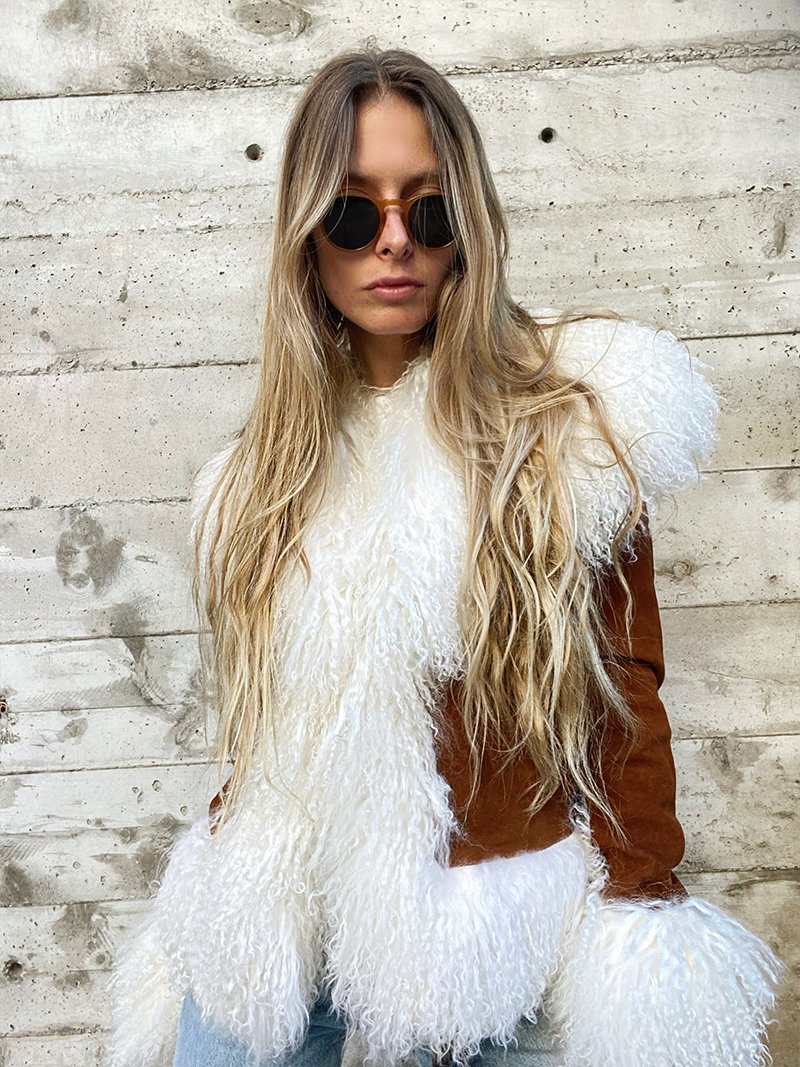
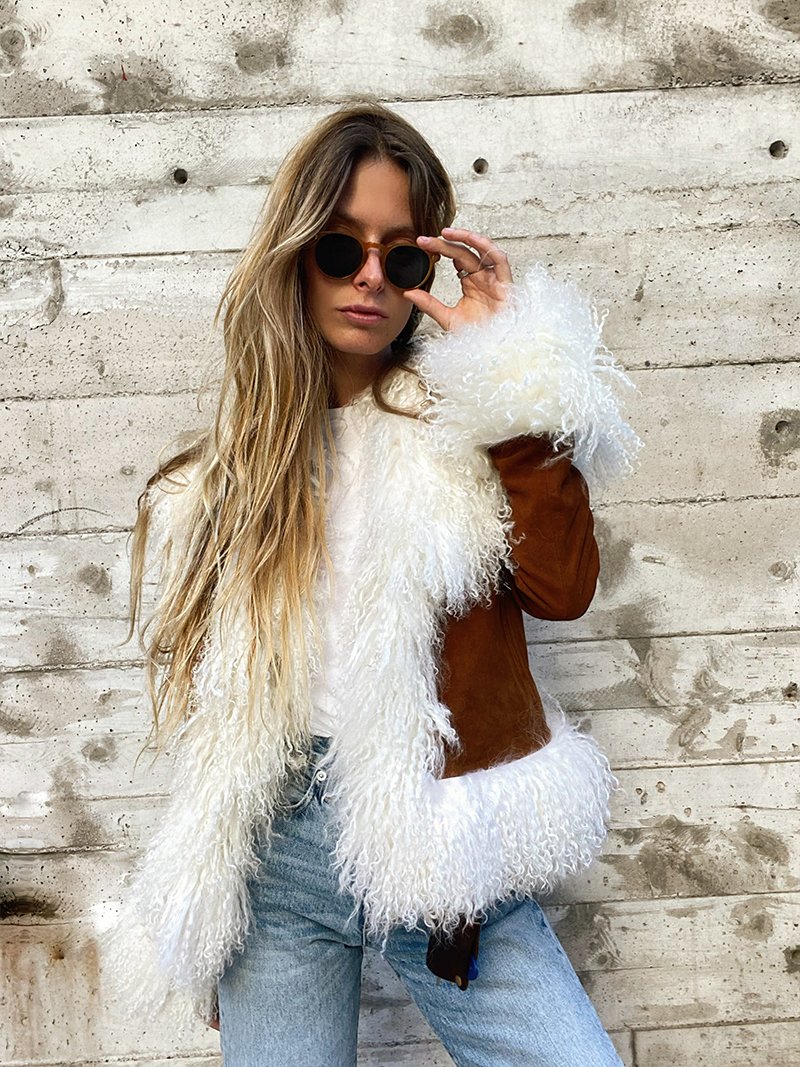
‘ LIVING IN NEW YORK GETS MY CREATIVE JUICES FLOWING JUST BY SIMPLY WALKING THE STREETS. THE CULTURE, THE ENERGY, IT’S DIFFERENT EVERY DAY. YOU CAN BE WHOEVER YOU WANT IN NEW YORK. NO ONE CARES. AS LONG AS YOU ARE CONFIDENT, IT’S YOUR WORLD! ’ — PAMELA TICK.
DC: Are there people close to you – in your family, friends, mentors – you look up to for guidance that helped sharpen your creative intuition?
PT: I look to friends and family often to help sharpen or support my creative intuitions. My husband is my better half here, though. He says he’s the brains behind the beauty, but I say he’s the brains and the beauty.
DC: If you were to give one solid piece of advice to anyone wanting to learn how to DJ, what would it be?
PT: Have fun with it. Don’t take yourself too seriously. There is no better feeling than letting go when you are DJing and being part of the dance fest and high-energy atmosphere that you’ve created.
DC: What keeps you motivated in your daily life? Do you have set regimens, healthy habits, self-care routines you can’t do without?
PT: I love my “me time.” Whether it’s a morning drive with a new playlist, stretching and pilates, hair masking, hot baths, making my own nut milk, cooking, or making my nightly lemon honey water – these little things bring me so much joy and comfort in my own home and skin.
DC: Can you share something about yourself people may not know?
PT: Love THC
DC: All things aside, what has been your favorite moment of this year?
PT: By the time this article is published, I’ll be skiing in Colorado, which will be a nice change of scenery.
DC: What do you hope to be remembered for most?
PT: Making people feel good


On New York:
Favorite coffee shop:
Birch UES, Abraćo, and Bluestone Lane
Best conversation with a stranger:
Taxi Drivers
What you’re listening to:
Moby, Petit Biscuit, Damian Marley
In your free time you:
I try and keep a pulse on the things I love – music, art, decor, and sitting on the
couch with my bulldog
A secret to living in New York:
If you can make it in New York, you can make it anywhere
Best weekend getaway:
The mountains are calling…
Home is:
where my dog is
Queen

Alanis

Rimon

Kitty
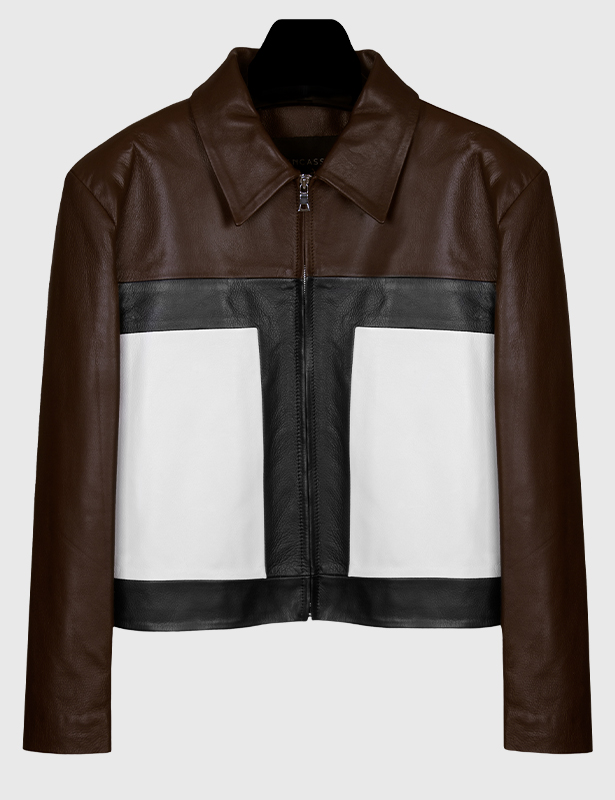
Jane

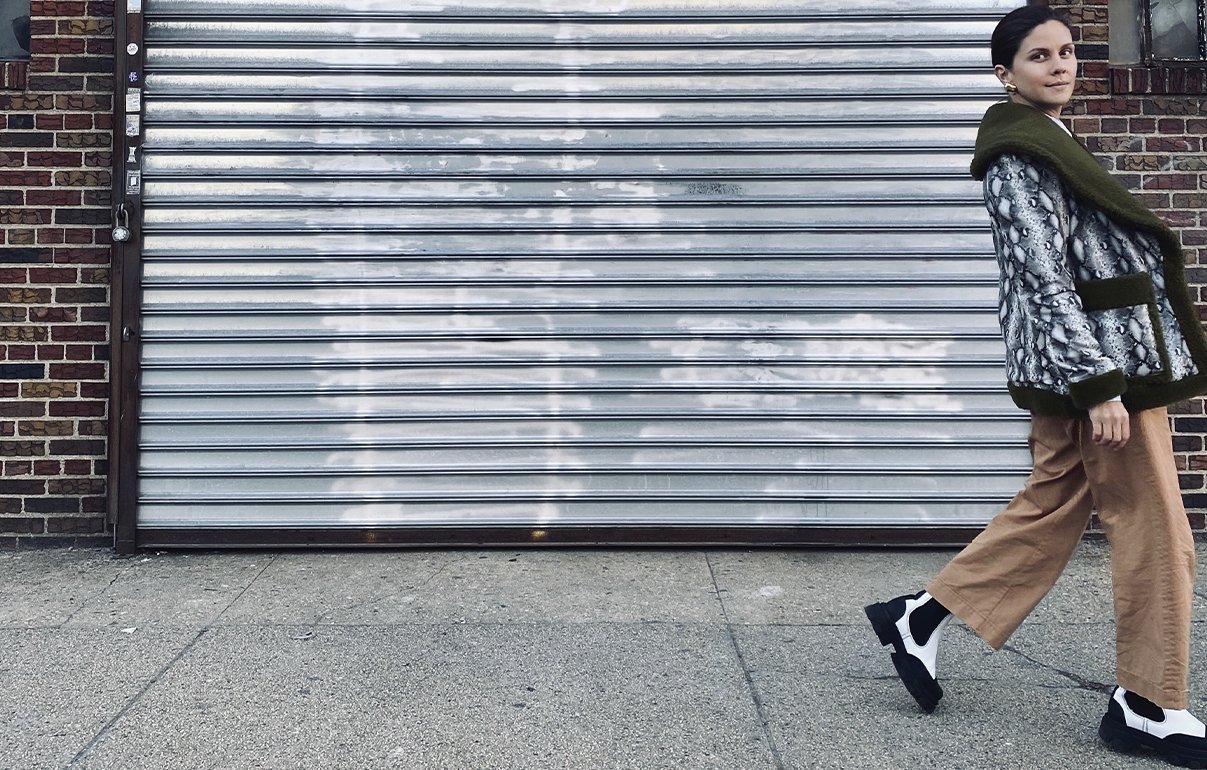
DANCASSAB
VOICES
MÓNICA
SORDO
Monica Sordo was well on her way to becoming a designer long before she knew the journey had begun. Although this path may have been unsurprising to those close to her given Monica’s precise eye and affinity for curating scale, purpose, and comfort in her surroundings – from creative output to personal style and decor choices. These talents that come so naturally for her are precisely what led to manifesting the eponymous jewelry collection she first launched in 2012 following a return home to her birthplace.
Born in Caracas, she left to study abroad at an early age in Milan at the Istituto Marangoni. After university, she initially settled in Madrid, where her first fashion industry role began at Marie Claire magazine before taking a teaching position at the Instituto Europeo di Design. Throughout her stay in Madrid, she began to question this trajectory, believing her purpose might be on the other side of the fashion styling and merchandising coursework she studied. On a voyage back to her native Venezuela, Monica found herself re-immersed in the influences of her father’s industrial design workshop and her mother’s creative sensibility while becoming reacquainted with the breathtaking scenery that now finds its way into every collection she conceives. This auspicious timing at home is what cemented Monica’s desire to shift direction and pursue what is now clear to be her lifelong calling: to create timeless, collectible objects that pay homage to the heritage, landscape, and craftsmanship of Latin America.
“When I was a baby and growing up, we had a weekend home an hour away from the city on the coast of central Venezuela. The house was at the very tip of a mountain and overviewed the majestic open Caribbean sea. This house was handmade from scratch by my father and grandfather, who became my biggest influences. That view is part of who I am is a memory that is part of my hard drive; the way the mountains drop into the sea and draw a sharp yet organic line in between a green and blue block is just so powerful.”
Moving to New York City in 2009 to take a position with Christian Louboutin, she simultaneously studied Jewelry Design at the Gemological Institute of America. The influence of the city’s Art Deco architecture shaped her work, adding another layer to the collective elements – both naturally occurring and man made – that shape her renowned designs. Monica’s signature, oversized pieces occupy equal space between sculpture and sophisticated statement accessories.
Monica is committed to sustainably crafting jewelry alongside a team of artisans in Peru – specifically from San Juan de Lurigancho, one of Lima’s most underprivileged districts. As a firm believer in contributing to a more equitable society, Monica works with a Fair-trade International-certified atelier to ensure a safe work environment exists to foster younger talent in their pursuit to master valuable crafts such as these. In merging her innovative design practice with ancestral crafting techniques, she infuses new purpose into ancient traditions for future generations to cherish.
With a new venture into designing home decor on the horizon, Monica is determined to continue working with Latin American artisans to guarantee the same craftsmanship is upheld. “I’ve been so attracted to lighting and have been studying about it over the past months, so the first collectible objects we will be launching are wall lamps as we introduce glass as our newest medium. I’m very excited as this project gives me the opportunity, or better said, has pushed me out of my comfort zone and made me explore new territories. These first objects are currently being developed in Mexico City and Oaxaca.”
As a Latin American brand committed to the same ethical and sustainable practices, Dan Cassab is honored to present Monica Sordo for our Voices series.

‘ WHEN I WAS A BABY AND GROWING UP, WE HAD A WEEKEND HOME AN HOUR AWAY FROM THE CITY ON THE COAST OF CENTRAL VENEZUELA. THE HOUSE WAS AT THE VERY TIP OF A MOUNTAIN AND OVERVIEWED THE MAJESTIC OPEN CARIBBEAN SEA. THIS HOUSE WAS HANDMADE FROM SCRATCH BY MY FATHER AND GRANDFATHER, WHO BECAME MY BIGGEST INFLUENCES. THAT VIEW IS PART OF WHO I AM IS A MEMORY THAT IS PART OF MY HARD DRIVE; THE WAY THE MOUNTAINS DROP INTO THE SEA AND DRAW A SHARP YET ORGANIC LINE IN BETWEEN A GREEN AND BLUE BLOCK IS JUST SO POWERFUL. ’ — MÓNICA SORDO.


DC: Could you tell us a bit about your early creative influences and your journey to where you are today?
MS: I grew up surrounded by metals, woods, and tools in my father’s industrial workshop… Well, workshops! The workshop would move with us from home to home and kept growing ….it has always been his hobby. I was the girl and the boy in the house, and as much I liked fashion since I was little, I did spend more time with him fixing something or putting a super cool project together for school than with dolls, shopping, or in dance classes. A decade after I left home to study in Milano, I realized what a big impact this experience had on me, and I began to suspect that my calling lay elsewhere, returning south to the heartland.
I started developing my first pieces in collaboration with him and my mom, who has developed a new career as a silversmith after her retirement. Surrounded by their creative sensibility, I embarked on this quest of forging collectible pieces that explore the pursuit of permanence through design, heritage, and craftsmanship.
DC: Growing up in Venezuela, you were surrounded by beautiful landscapes which still inspire the MS collections today. What are some of your earliest memories of these places? How did you approach the initial transformation of such poignant visuals into designed objects and jewelry?
MS: When I was a baby and growing up, we had a weekend home an hour away from the city on the coast of central Venezuela. The house was at the very tip of a mountain and overlooked the majestic open Caribbean sea. This house was handmade from scratch by my father and grandfather, who became my biggest influences. That view is part of who I am is a memory that is part of my hard disk, the way the mountains drop into the sea and draw a sharp yet organic line in between a green and blue block is just so powerful.
I could go on and on about visual memories from when I grew up. But I always like to mention that the arrival of modernism to Latin American happened through Venezuela. Caracas was the Mecca of Mid Century Architecture and Design and played a fundamental role in the Kinetic Art Movement. Jesus Soto’s public penetrable sculptures were my playground; Calder decorated the ceilings of the theater hall we frequented on Sundays. I met Bruno Munari as a kid and played with him and his mobile sculptures when he visited as part of a cultural program at a bank where my mom used to work in marketing. There is a video of this! I have to share it with you!
DC: Your personal style is always effortless, structural, and timeless… Much of the imagery in your campaigns and content you share – both personal and inspiration – comes from the same place…rooted in your creativity. What can you share about this?
MS: I like being comfortable. I’m comfortable if I look elegant, I’m comfortable if I’m not wearing makeup, but my skin looks and feels great. I’m comfortable when I’m wearing great fabrics, I’m comfortable wearing clothes that fit my body right, I’m comfortable wearing light yet bold jewelry…this is the definition of being timeless and effortless; to be comfortable in your own skin. No time or era defines my style because it is very personal as my day to day inspiration lies in my roots and my own experiences. Even though there are many many layers of how this influences my work and my style…what can be more effortless and timeless than our roots?
DC: Does design run in your family? Who might you credit with playing a significant role in shaping your creative disciplines?
MS: I have mentioned my parents already a few times! Even though they dedicated their careers to more corporate yet creative and successful positions, they always loved design. They were autodidacts in the new fields and passions they wanted to explore, which I find fascinating. As a matter of fact, I didn’t go to design school either; I did economics and fashion merchandising…so I guess it runs in our blood! They are my biggest mentors and role models. From my dad, I learned about precision, manufacturing processes, quality, and team management… from my mom, I learned to develop my sensibility and find beauty even in the most unexpected places.
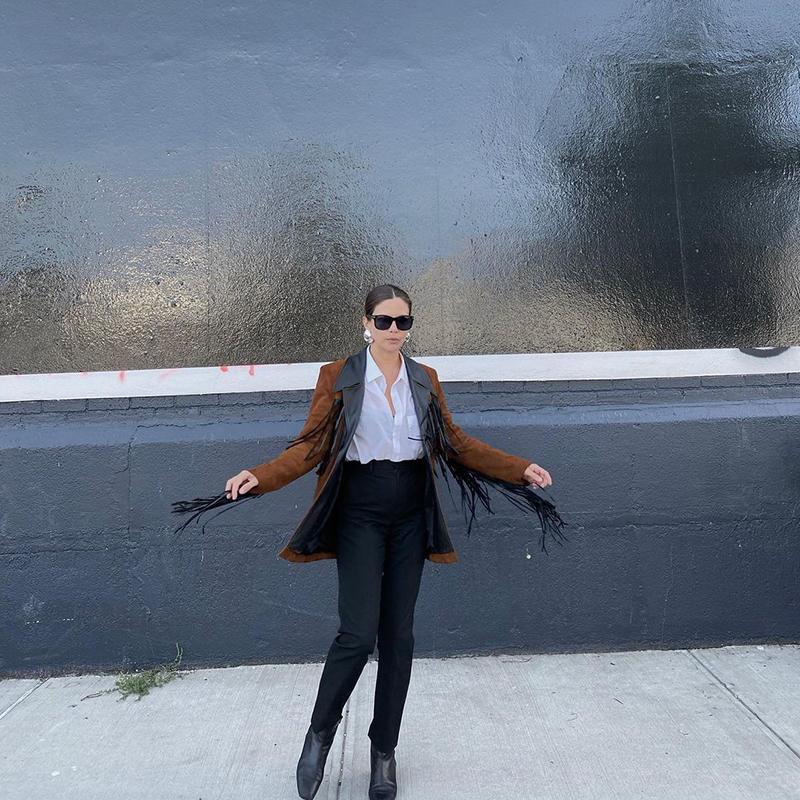

DC: You have mentioned a potential venture into sculpture and home. Can you share a bit about the direction you are taking? When and where will you show your work?
MS: I am happy to announce that we are finally working in full on this project very organically and taking the time to really understand how to scale up from our tiny pieces of jewelry. I am learning how to transition into a more multifaceted creator and detach naturally from the jewelry designer persona without losing our DNA and making sure to get our current Peruvian artisans involved. Keeping the craftsmanship from the region is one of the main focuses. I’ve been so attracted to lighting and have been studying about it for the past months, so the first collectible objects we will be launching are wall lamps as we introduce glass as our newest medium. I’m very excited as this project gives me the opportunity, or better said, has pushed me out of my comfort zone and made me explore new territories. These first objects are currently being developed in Mexico City and Oaxaca.
DC: What have you learned about your process through your more recent work? How has your approach from concept to creation changed?
MS: These past 10 months have been extremely challenging. I always thought: What would I do the day I can not visit my artisans and workshops in Lima? As I develop hand in hand with them. Unfortunately, that day arrived due to a global pandemic that paralyzed yet awakened the world in many ways.
I did realize I was so dependent on being there and micromanaging to develop new ideas, which kept me away from new projects and evolving. It was time to develop new communications tools with the team and profit from the creative flow and outstanding quality and trust we have developed in the past 5 years working together. So I will say I have learned to delegate, trust my team, and work with more time in smaller collections.
DC: What is the most important thing you consider before introducing something new into the world of your own creation?
MS: Volume, Weight, and Functionality


‘ BEING MORE MINDFUL HAS BECOME MY MAIN MOTIVATION. IT IS NOT AN EASY TASK, BUT IT IS SO REFRESHING TO NURTURE YOURSELF WITH THIS PRACTICE. ’ — MÓNICA SORDO.
DC: Does living in New York play a major role in your creative process? How has your time in Miami impacted your approach to work differently?
MS: It definitely has! You can see in my first collections a strong Art Deco influence. With time though, I understood that the Art Deco movement was born through the composition of earlier ones such as cubism, futurism, De Stijil, and many others… So to that point, New York allowed me to not just have access to some of the most amazing art collections in the world, keep training my eye and my own style, but it also gave me that energy and mojo that is hard to explain but makes you so creative and strong.
On the other hand, Miami has helped me be more eloquent in the more organic discourses that characterize my latest work. There is that Caribbean vibe and the feeling of being closer to home. The mesmerizing and dramatic sunsets have even made us evolve into a new core color palette.
DC: How do you stay motivated? What is the most important part of your day?
MS: Being more mindful has become my main motivation. It is not an easy task, but it is so refreshing to nurture yourself with this practice.


On New York and Miami:
Favorite local coffee shop or restaurant:
La Natural (Mia)
Your signature drink order:
Fresh orange juice with a splash of Campari
What you’re reading:
Wherever you go, there you are. by Jon Kabat-Zinn
What you’re listening to:
CLASSIXX
Favorite museum or gallery:
Spinello Projects (Miami)
In your free time you:
Let the Martha Stewart inside me cook for my family and friends.
Where you find peace:
Home.
Home is:
Where I find peace.
Taylor
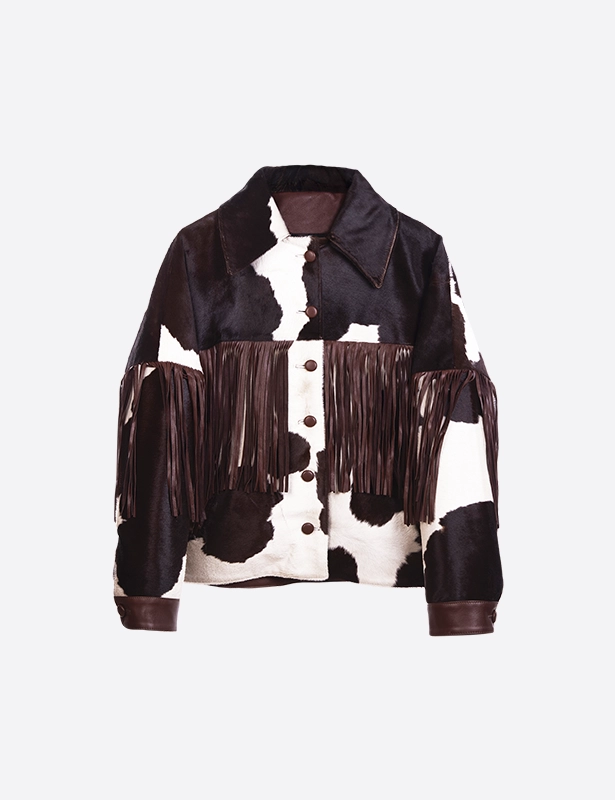
Patsy
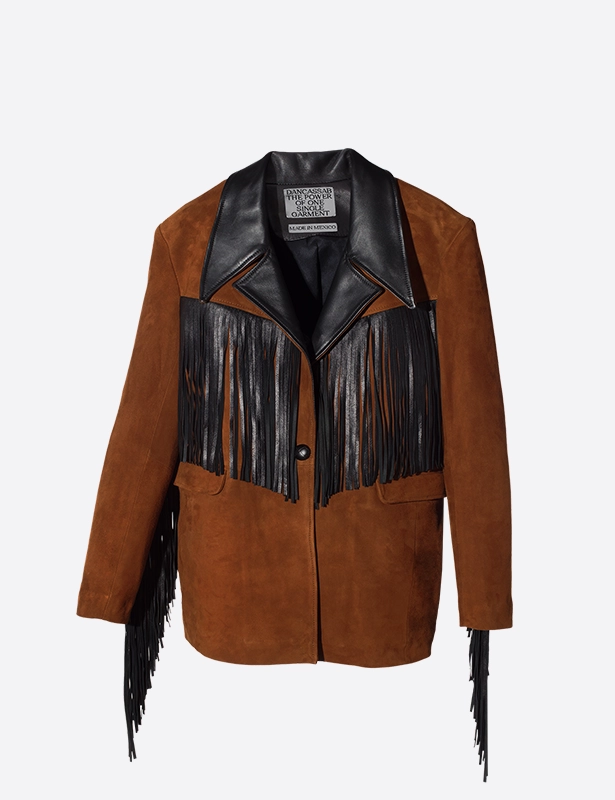
Floyd

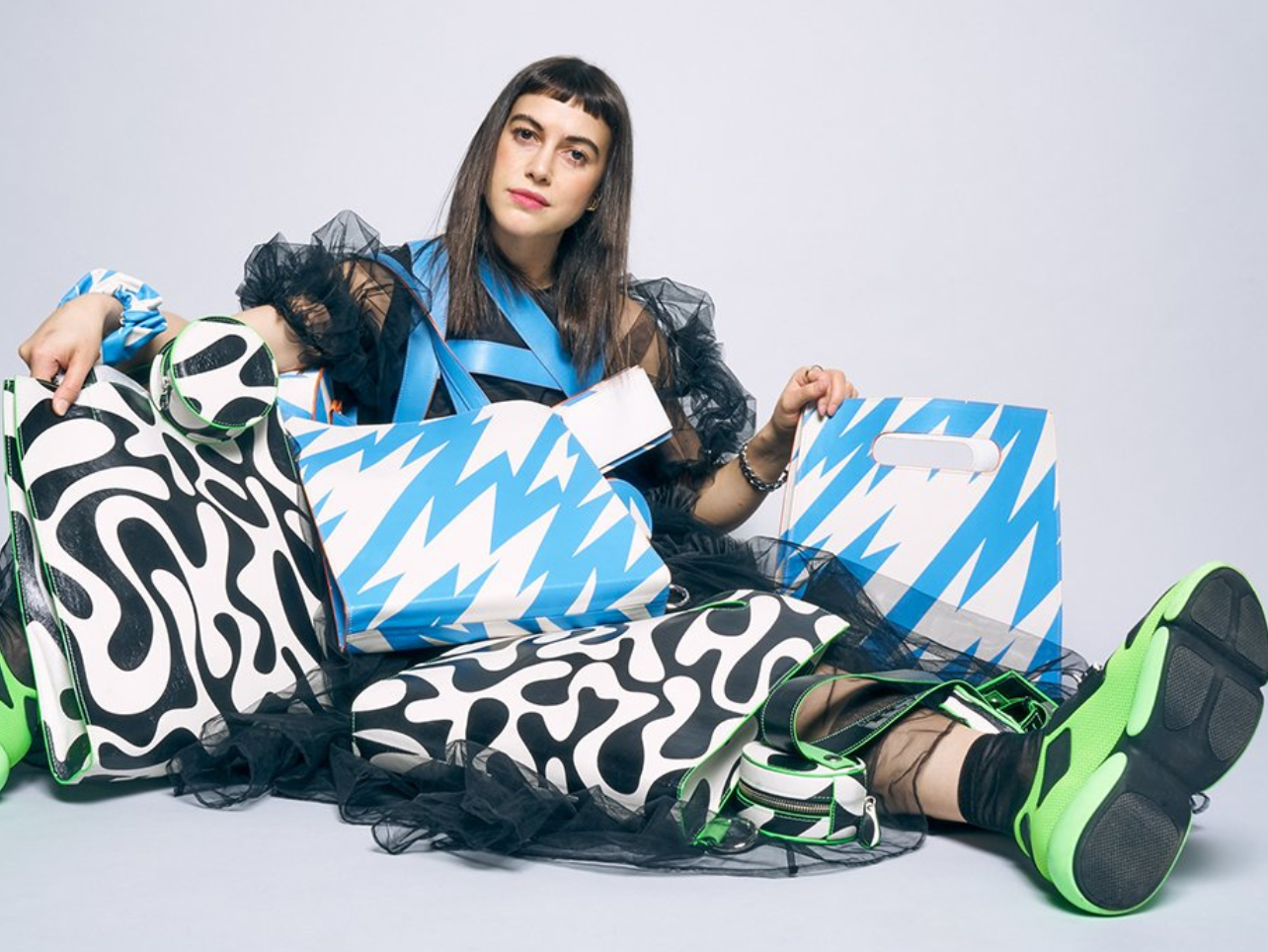
DANCASSAB
VOICES
LETA
SOBIERAJSKI
Words: Leta Sobierajski, Interview: Kristom Parson
We are pleased to introduce Leta Sobierajski, artist and co-designer of the Dan Cassab x Leta Sobierajski collection – our first leather accessories range done in collaboration with creative director and founder Daniela Cassab.
An independent designer and art director based in New York City, Leta’s multi-media practice explores visual journeys through combining traditional graphic design elements with photography, art, and styling to produce viscerally stunning tableaus. As one-half of the creative studio, Wade and Leta, a style they have dubbed ‘Music To Your Eyes,’ comes alive, where speculative design converges with colorful mediums forming a familiar personality throughout their work. Counting in her arsenal of inspiration are such lauded visionaries as Rei Kawakuba and Arakawa and Gins, the latter to whom she attributes, “Their work has made us consider the physical effect of the work that we make and has even encouraged us to create our own work philosophies such as “design as performance,” to give a greater understanding to the physical activity we strive for in the work we create, whether through a brand, a sculpture, or an ad.”
To fully grasp the breadth of Leta’s imagination, it is essential to understand that her artistic process begins with considering the holistic experience as both the creator and the beholder. This practice is one she began to hone from a young age growing up in a small rural town in upstate New York. It was among the vast acreage surrounding her childhood home, filled with trees and beautiful stillness, that the curiosity she approaches her work with today began to take shape. She recalls, “With a surplus of nature at my disposal and no siblings to play with, my imagination would run wild as I traversed streams and climbed trees, imagining that I was running alongside fantastical creatures with batons in my hands (sticks, of course) and inspecting a world untouched by human hands. I’d write, draw pictures, and write stories about my discoveries and record myself on a tape recorder interviewing these creatures that I found (I wish I had these tapes still!). It sounds like it was a very lonely existence, but I can’t imagine an alternative.”
Leta’s work explores the space between more conventional identities and pushing boundaries into bizarre compositions. The color-charged, overarching optimism conveyed in both her artwork and personal style is what captivated us at first sight. When the opportunity to collaborate became possible, it was a refreshing and motivating reward to learn her creativity was even more boundless than we expected. In our first virtual meetings last year, there were shared sentiments of relief to co-create again during one of the most isolating and troubling times in history. As creators, the interaction between tangible things – whether tools, materials, or individual people – is an essential requirement and great privilege. So, perhaps conjuring the strength on behalf of every creative mind feeling the weight of a future then unknown, Daniela and Leta set forth with shared determination to bring something entirely new into the world for both of them.
For the initial collaboration, Daniela and Leta designed a limited-edition t-shirt benefitting Project Paz’s COVID at the Border initiative, with 50% of the proceeds donated to support communities in need on both sides of the U.S. and Mexico border. Leta interpreted her signature bold graphic and text‐based work into empowering motifs featuring the phrases ‘We Are What We Think’ and’ ‘Love Thy Neighbor’ to show the solidarity and respect Americans have for their Mexican neighbors.
Not unlike her early ventures into the unknown, throughout her artistic evolution, Leta continues to challenge herself and her collaborators to not only make something appear but to ensure the impact of its presence is everlasting once discovered. As the duo embarked on designing leather accessories, equally important were shared values to preserve the product and design integrity while using the most sustainable production methods, from utilizing leather scraps from the brand’s cutting room floor, leftover from previous collections to selecting packaging and shipping materials. Combining Leta’s postmodernist/maximalist influences with Dan Cassab’s 60s rock n roll aesthetic, the resulting range brings Leta’s bold graphics to life over handcrafted leather to form a unisex, utilitarian assortment of handbags and accessories.
After what became a nearly year-long process from the first brainstorm to launch, this particular joining of art and fashion functioned as a source of catharsis and hope for the two creatives navigating uncharted territory. Taking comfort in problem-solving together effectively wrought a sense of peace and gave purpose to what seemed like, at times, a loop of endless chaos and uncertainty.
We are so grateful for the unforgettable experience of working with Leta. Looking back at the year behind us and looking forward at much to come, we hope these two mantras will guide you as swiftly as they did us, to believe that “We Are What We Think,” and remember to “Love Thy Neighbor.”
The Dan Cassab x Leta Sobierajski collection will be available on Monday, March 22, exclusively on Dancassab.com.
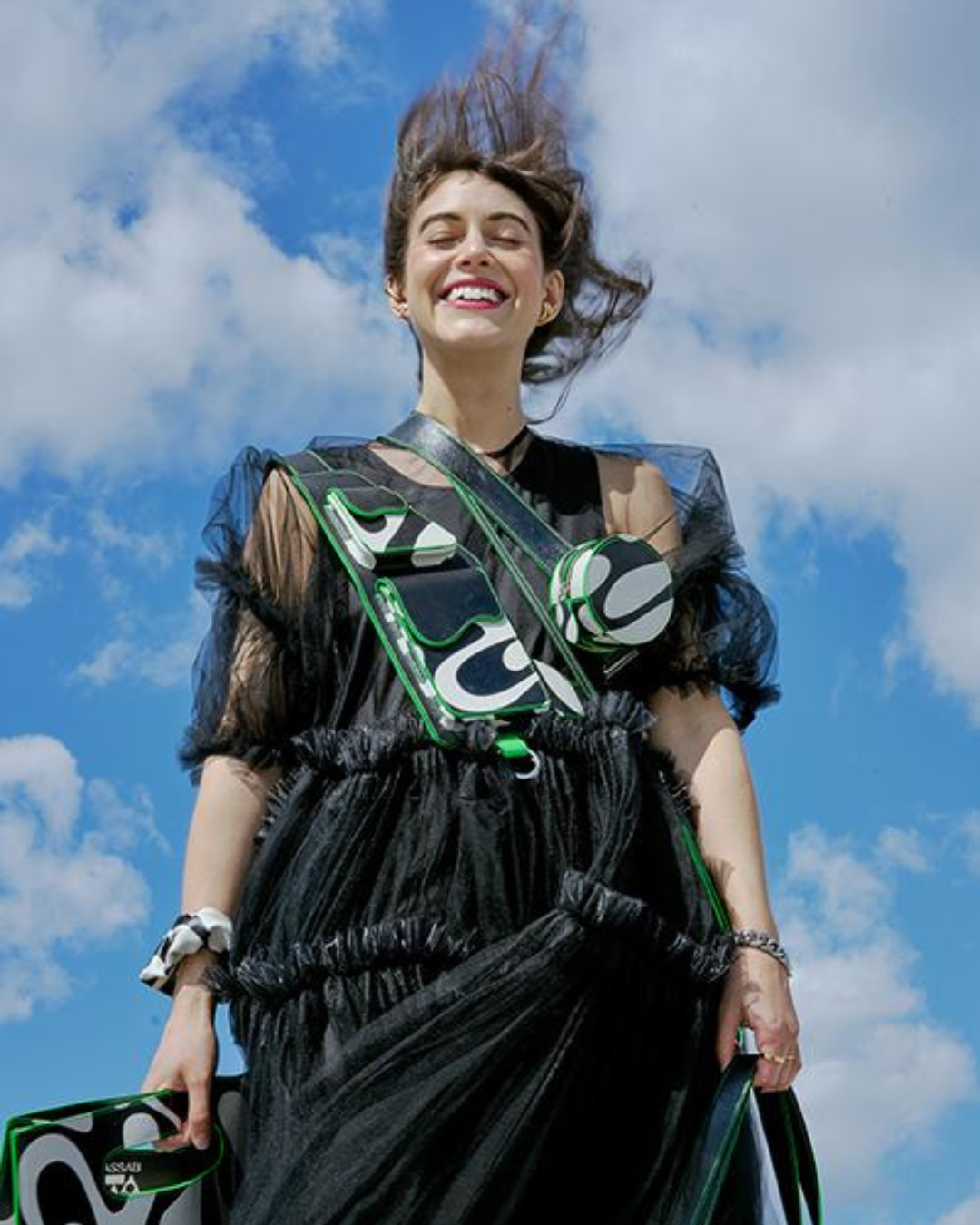
‘WITH A SURPLUS OF NATURE AT MY DISPOSAL AND NO SIBLINGS TO PLAY WITH, MY IMAGINATION WOULD RUN WILD AS I TRAVERSED STREAMS AND CLIMBED TREES, IMAGINING THAT I WAS RUNNING ALONGSIDE FANTASTICAL CREATURES WITH BATONS IN MY HANDS (STICKS, OF COURSE) AND INSPECTING A WORLD UNTOUCHED BY HUMAN HANDS. I’D WRITE, DRAW PICTURES, AND WRITE STORIES ABOUT MY DISCOVERIES AND RECORD MYSELF ON A TAPE RECORDER INTERVIEWING THESE CREATURES THAT I FOUND (I WISH I HAD THESE TAPES STILL!). IT SOUNDS LIKE IT WAS A VERY LONELY EXISTENCE, BUT I CAN’T IMAGINE AN ALTERNATIVE…’ — Leta SOBIERAJSKI.

DC: Where did you grow up? Can you remember your earliest form of creative output as a child?
LS: I’m from a very tiny town and grew up in a deciduous forest area in upstate New York where the changing of the seasons was probably the biggest event of the year. Outside of school activities, there wasn’t much to do; aside from studying, I spent my free time drawing and exploring the outskirts of our backyard (all 20 acres of it). With a surplus of nature at my disposal and no siblings to play with, my imagination would run wild as I traversed streams and climbed trees, imagining that I was running alongside fantastical creatures with batons in my hands (sticks, of course) and inspecting a world untouched by human hands. I’d write, draw pictures, and write stories about my discoveries and record myself on a tape recorder interviewing these creatures that I found (I wish I had these tapes still!). It sounds like it was a very lonely existence, but I can’t imagine an alternative.
DC: Where did you go to college? How did you decide to study graphic design?
LS: Once we got internet access (a difficult acquisition when you happen to live in the woods), I learned that there was more to drawing than just a pen and paper. I asked my parents for a licensed copy of Photoshop 7.0 for my 12th birthday, which I planned to use to color and improve my artworks. I spent more and more time indoors patiently waiting for my access to the outside world to load, pixel by pixel. I used DeviantArt as a portal to share my work and visited chat rooms to connect with other people who felt as estranged as I did. From drawing, I began to design posters, study technical drawing, and eventually signed up for classes in desktop publishing. By my final year of high school, I felt design was an industry that could help me tie all of these interests together.
I went to college at SUNY Purchase College, a school about an hour outside of New York City and four hours from my hometown. At that time, I was still so unaware of the world of art and design and schools like the SVA and RISD simply weren’t on my radar. Thanks to already being a New York State resident and my mother working for another SUNY school, my education was heavily discounted. I’d say that Purchase was a gentle introduction for me to the outside world and a suitable transition between my tiny town and my current “big city” living.
DC: Are there particular artists, cultures, movements, periods, or otherwise that you are influenced by?
LS: Arakawa and Gins – The ultimate working couple, Shusaku Arakawa and Madeline Gins were visual artists, conceptual writers, self-taught architects who believed that, through a radical recalibration of the built environment, humans could solve the ultimate design flaw: death. Their work has made us consider the physical effect of the work that we make and has even encouraged us to create our own work philosophies such as “design as performance,” to give a greater understanding to the physical activity we strive for in the work we create, whether through a brand, a sculpture, or an ad.
Despite how incredible, insightful, and batshit crazy their work has been, Arakawa and Gins have created very few architectural sites together, though they had originally planned for many more. Wade and I have taken it upon ourselves to visit as many of their sites as we can in hopes of further learning and understanding the brilliance that their work conveys. Ever since we discovered their work in 2016, we’ve been infatuated with their idea for growing backward in age by designing environments that become “interactive laboratories of everyday life” whose terrain and walls are deliberately realized in unexpected ways to keep a person ‘tentative’ so that they must actively negotiate even the simplest tasks. This heightened body awareness and the challenging of senses can, they believed, allow the body to constantly re-configure itself and with time become a means to strengthen the immune system. Bioscleave House fundamentally proposes an architecture of viability that helps to sustain one throughout life, and even extend human lifespan indefinitely.
Rei Kawakubo – The evolution of her brand, Comme Des Garcons, over the course of several decades has been forever inspiring to me. Her work challenges the shape and idea of the human body and interchangeability of femininity / masculinity and makes me reconsider the functionality and utilitarianism of everyday clothing. She also gives me the motivation to be a successful woman without having to exude the typical tropes of womanhood.
I’m also heavily inspired by the fantastical storytelling of the Final Fantasy game series, and find that the games that I played in my younger years still contribute to the ambitious storytelling and positivity that I carry with me today. Plus, the stylistic choices of the main characters are likely what gave me an inherent curiosity about fashion in my more current years. These stories give me this otherworldly superhero-esque feeling of purpose in the work that I make, encouraging me to succumb to ideas of escapism and the grandiose dream and desire for building an alternative world to offset our daily lives.
DC: To what extent do they infiltrate your world as an artist, in your home, or personal style?
LS: I don’t see a separation between work and life, and nor do I see a separation between the persona of myself and the persona of me as a designer. Both go hand in hand, and therefore I surround myself with the work and writing of those who inspire me. Our home is painted in many bright colors with accented trimmings—most of which are leftover from set design and sculpture projects and are a testament to the many colors we have used in our work. The artwork on our walls and shelves is made by many of our friends and role models. My personal style can sometimes be a little less colorful than the work I make, but what it lacks in chromatic joy it makes up for in silhouette and structure. Wade and I have also taken up the interest of collecting figures from games and anime that have impacted us (like Akira, Final Fantasy, Evangelion, etc.), so our shelves have gotten a lot more playful.
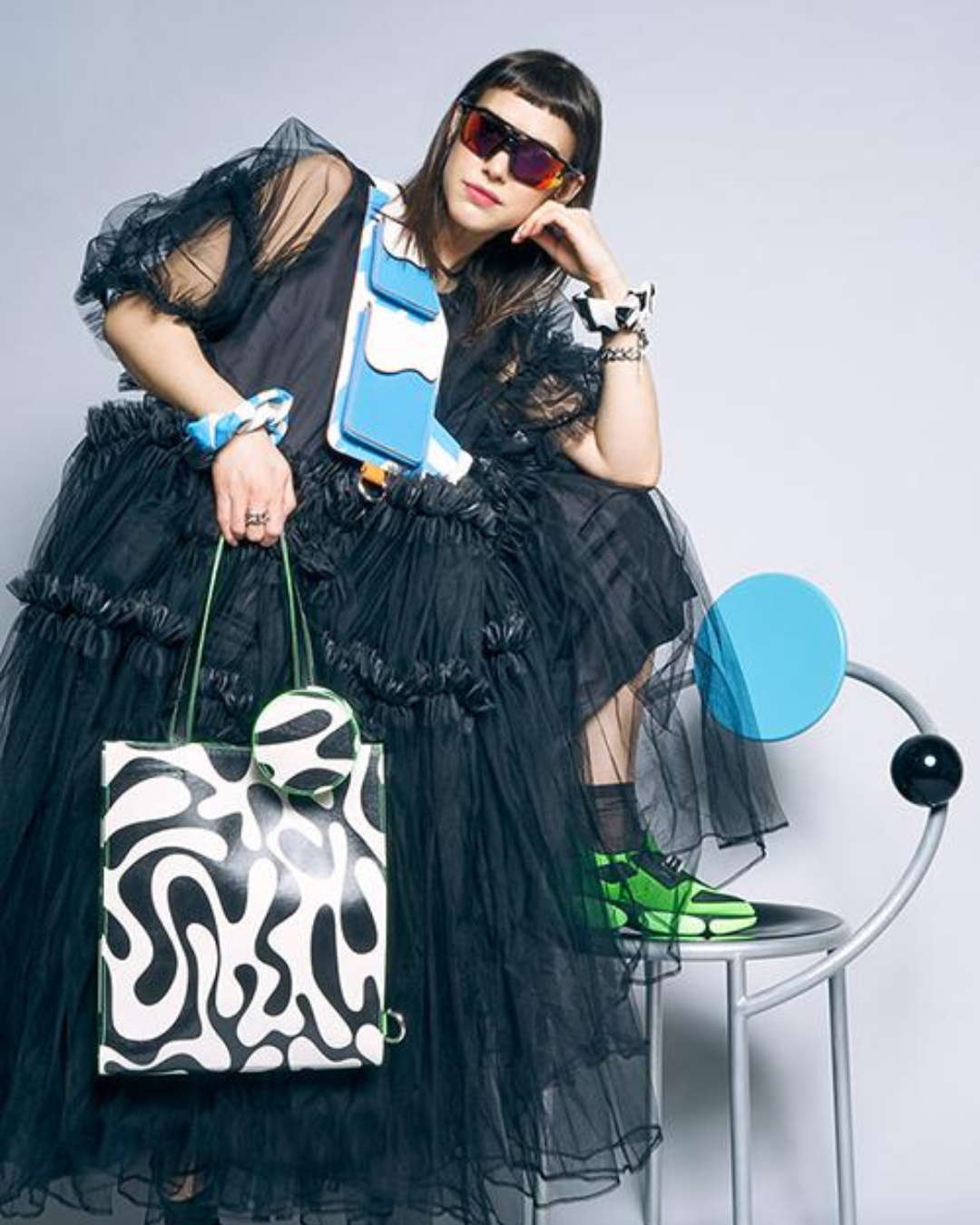

DC: How did you hone your signature style? How has it evolved over the years – both pre-Wade and Leta and post?
LS: Saying it’s a signature style is so kind! I honestly still feel like it’s something I’m figuring out, so I’m flattered that it has some sort of distinction. I’ve always been attracted to sculpture and landscapes and architecture, and so I naturally gravitated towards exploring the physicality of design. While I was taught that graphic design, at its essence, was focused on logos, typography, posters, and books, these elements weren’t enough to keep my attention in university. I always wanted to do what I wasn’t being taught in the classroom. Hence, I was often found in the woodshop working with sculpture majors’ offcuts or barricading myself in the basement for a photoshoot with whatever I could find. This hands-on approach led to a fascination with the materiality of design and how I didn’t need to be confined to one aspect of an industry to make it feel like my own.
My personal projects were born from ideas that I couldn’t make on the computer, and incorporating my own physicality with my photography was the solution that would help make my concepts sing. Incorporating myself and my body into my work felt like a natural evolution because of a very unglamorous reason—I didn’t have the money to hire someone else to do it. Vanity is not the intention here; it’s simply to save a few bucks. When I met Wade, he very quickly adapted this technique, and we began to make work together using these principles. We both grew up playing sports and being active, and so using our bodies to conquer our conceptual challenges felt like a natural evolution of our skillset as designers.
DC: Do you and Wade create balance through opposites or do you find yourselves aligned on most projects?
LS: As individuals, we are much different from one another, and that is quite apparent in our work. I love the smaller details and really refining things, whereas Wade is more gestural with his work and likes to iterate to define a feeling. It really works out because we openly collaborate and share files to make sure we can catch each other when we are going a little too crazy. Everything is about balance and harmony and how we can attain it through dialogue and collaboration.
DC: What is most important to you when considering a new project?
LS: For me, it’s most important to find new opportunities and novel solutions. I love being able to work with brands and people who see merit in what we do and help us push our own boundaries within our offerings as a studio. There’s beauty in someone being able to see our work and recontextualize it in a way that might offer a solution in a way we could not previously imagine. I consider each project to be a stepping stone for us to expand our skillset, and truly, we wouldn’t be able to do this without the trust and support of those who choose to work with us. Our values are simple, and our biggest ambitions are always to make something we’ve never made before.
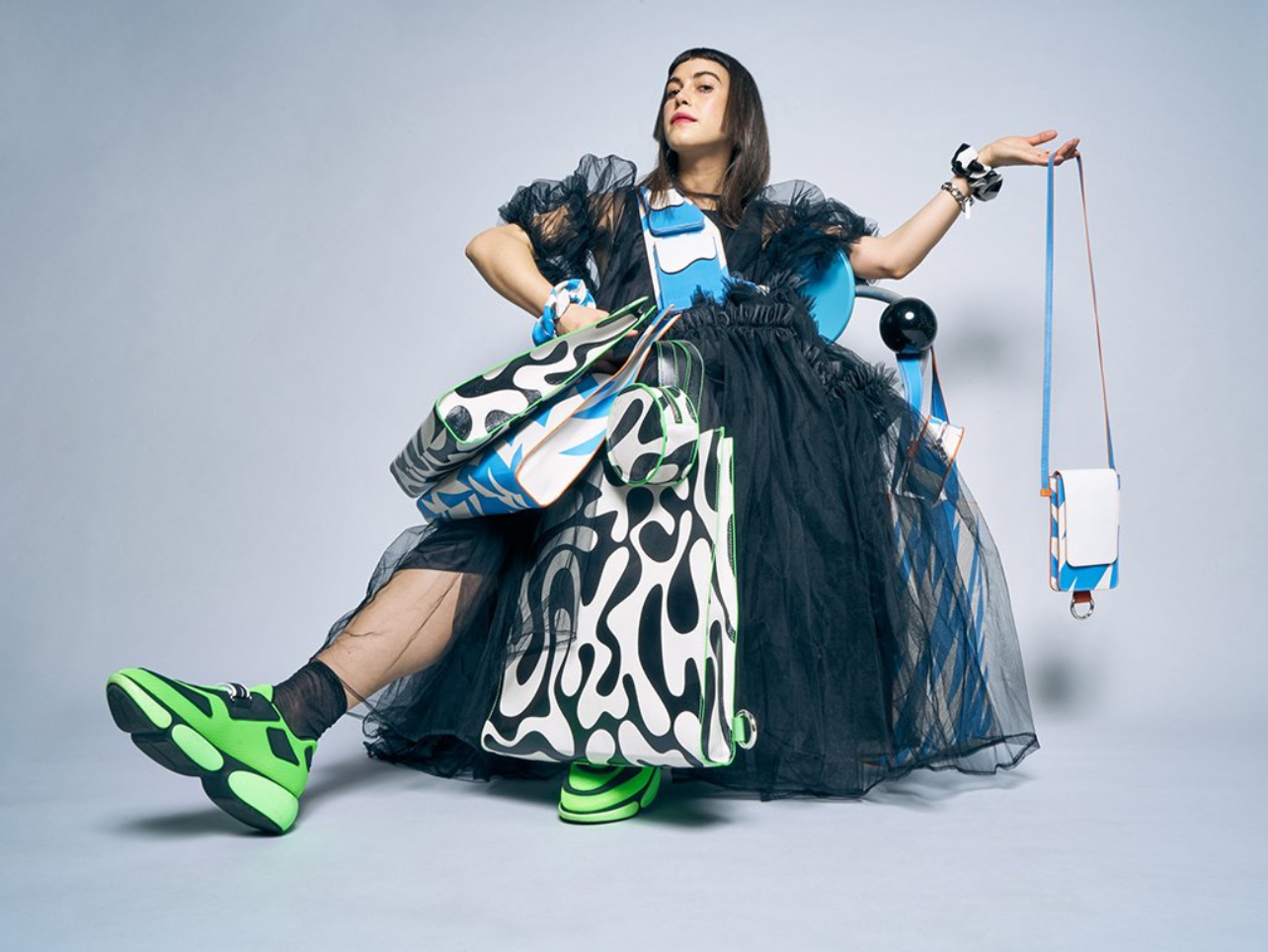
‘ THEIR WORK HAS MADE US CONSIDER THE PHYSICAL EFFECT OF THE WORK THAT WE MAKE AND HAS EVEN ENCOURAGED US TO CREATE OUR OWN WORK PHILOSOPHIES SUCH AS “DESIGN AS PERFORMANCE,” TO GIVE A GREATER UNDERSTANDING TO THE PHYSICAL ACTIVITY WE STRIVE FOR IN THE WORK WE CREATE, WHETHER THROUGH A BRAND, A SCULPTURE, OR AN AD. ’ — Leta SOBIERAJSKI.
DC: You have worked with a range of brands from design to fragrance and beyond. Was there anything particularly appealing or different about working in the fashion space with Dan Cassab?
LS: I really appreciate what Daniela has created and was already a big-time admirer—Dancassab feels like it is designed for the unapologetically ambitious woman (or person) who has great dreams and even greater goals. I’ve never worked in the fashion space before but have been extremely keen to explore it, and Daniela’s positive energy and endless ambition felt like the perfect invitation. I’ve learned so much from every person I have collaborated with, and I feel like working with DanCassab has been one of the greatest learning experiences thus far.
DC: What would you say your greatest challenge was when approaching the collaboration from a design perspective?
LS: Having no limits is always going to be my greatest challenge. As a person who thrives on constraints and self-proclaimed rules, being given an open floor to construct ideas is intimidating, nerve-wracking, and liberating, all at once! Originally we discussed designing a t-shirt and some patterns, and I’m grateful that Daniela was enthusiastic when I presented page upon page of ideas for how to take this collaboration to the next level, taking me way out of my comfort zone as I thought about silhouettes, hardware, functionality, and wearability. I honestly never thought that we would make everything we discussed, and I keep on pinching myself when I look at the lookbook because I still can’t believe it’s all real.
DC: What is the greatest risk you’ve taken so far as an artist?
LS: Acknowledging that sometimes our initial dreams aren’t always the right dreams. Before I began working individually, I was truly set on working my way to the top of the ladder at a studio, but was soon disenchanted when I understood the realities of those studios I worked for. I wanted to build a safe space for myself that did not depend on titles to define what I do, so I could freely explore mediums and materials without having to justify the reason.

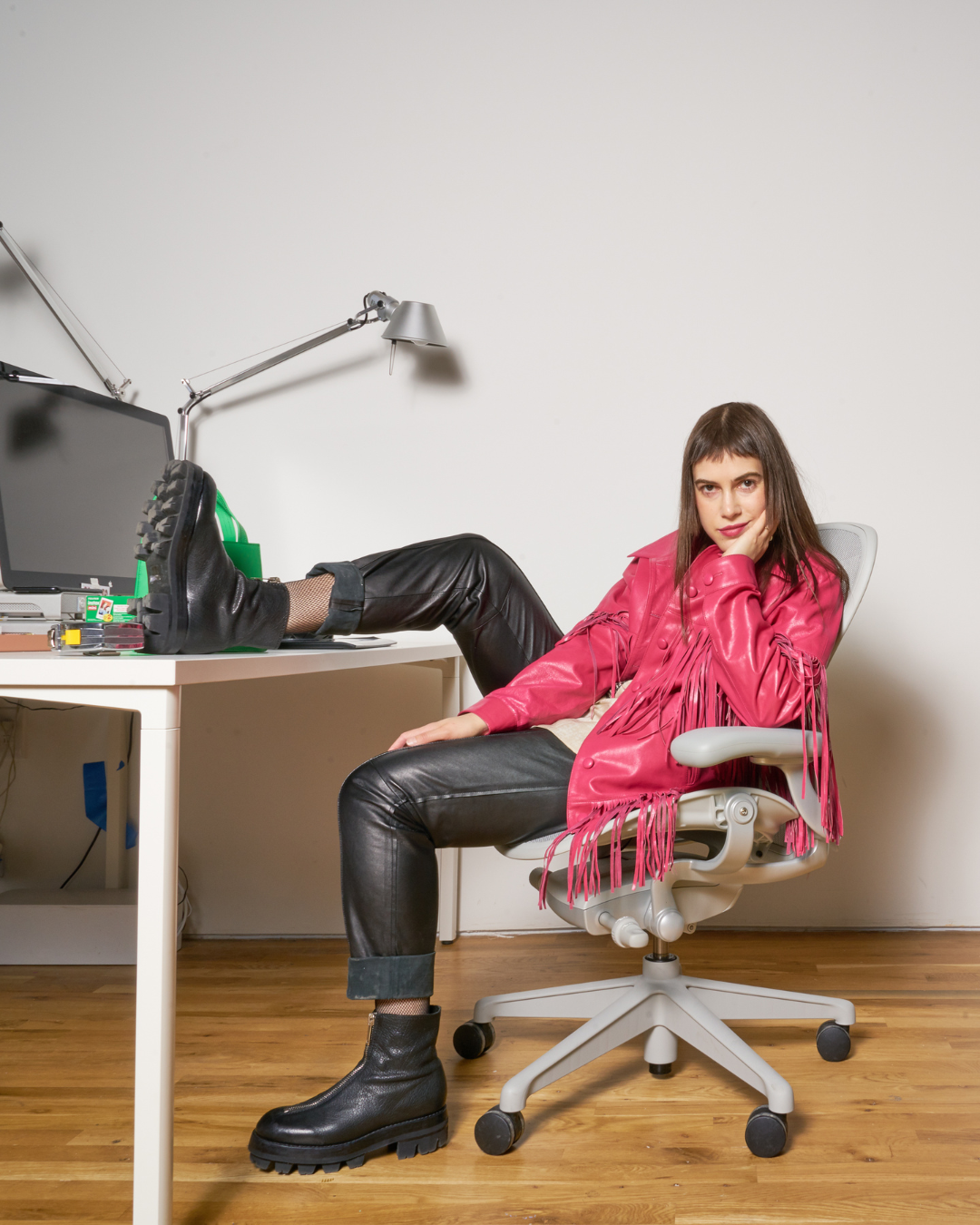
‘ I DON’T SEE A SEPARATION BETWEEN WORK AND LIFE, AND NOR DO I SEE A SEPARATION BETWEEN THE PERSONA OF MYSELF AND THE PERSONA OF ME AS A DESIGNER. BOTH GO HAND IN HAND, AND THEREFORE I SURROUND MYSELF WITH THE WORK AND WRITING OF THOSE WHO INSPIRE ME. ’ — Leta SOBIERAJSKI.
DC: Assuming public health and travel restrictions were not a factor, what would be your dream project?
LS: For years now, we’ve wanted to design a playground that could appeal to both children and adults. There’s something so extraordinary about seeing people interact with our work, and thankfully for us, color and pattern tend to attract people of all ages. We’d love to build a site that can be appreciated at any time of day without exclusivity.
When we created our Party for All in 2019, it really opened our eyes to the idea of how, despite us loving museums and galleries, our favorite artworks were experiences that promoted interactivity. We hope that at some point, somewhere around the world, we’ll be able to create a space (or series of spaces!) that can encourage people to be themselves, love one another, and embrace their sense of child-like wonder.
DC: Do you see the Wade and Leta studio expanding into other areas of design or creating materials or products?
LS: We’ve already started to explore the possibilities of public sculpture, intricate installations, and in 2021 we’re designing an entire factory space, so I think that our evolution into materials and products is only a matter of time. I’m fortunate that our educations could teach us such broad principles because I feel like they can be applied to every possible facet of our field.
On New York:
Your favorite…
Local small business:
Kettl Tea, Winson Bakery, Nick and Sons Bakery.
Restaurant:
Cerveceria Havemeyer, Rule of Thirds, Ten Bells.
Museum:
Rather than a museum, go to Chelsea and spend a day weaving in and out of galleries. It’s my
favorite way to gather inspiration and was Wade’s and my weekend regimen pre-pandemic.
Book store:
Karma Books, Dashwood Books.
Art supply store:
Artist & Craftsman Supply on Metropolitan.
Park:
Flushing Meadows Corona Park.
Clothing store:
Dover Street Market, Comme des Garcons.
Furniture finds:
Bi-Rite, Home Union, and Lichen, and our friend Francois Chambard who designed our most
extraordinary credenza.
Where you feel most at peace:x
In the comforts of my home with my headphones on.
Leta Collection

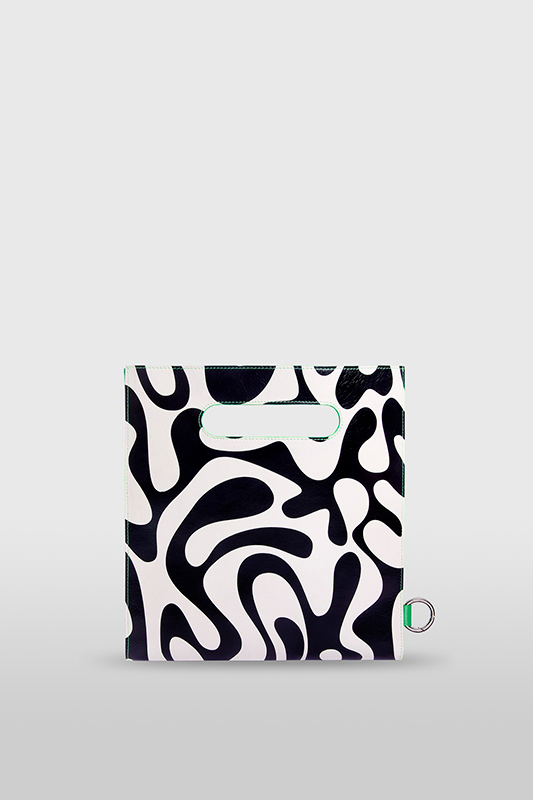

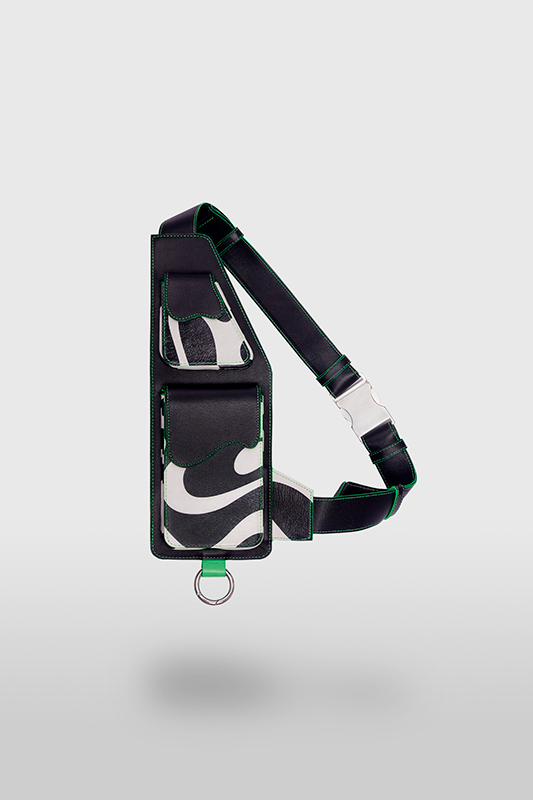

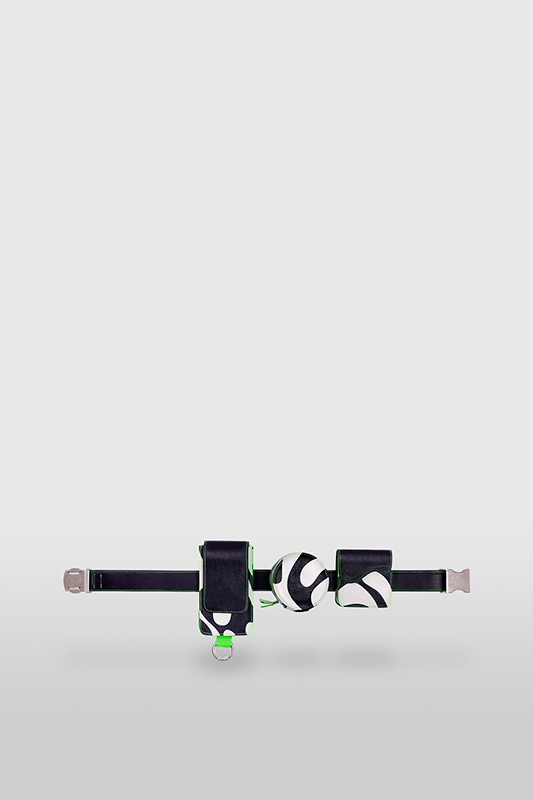


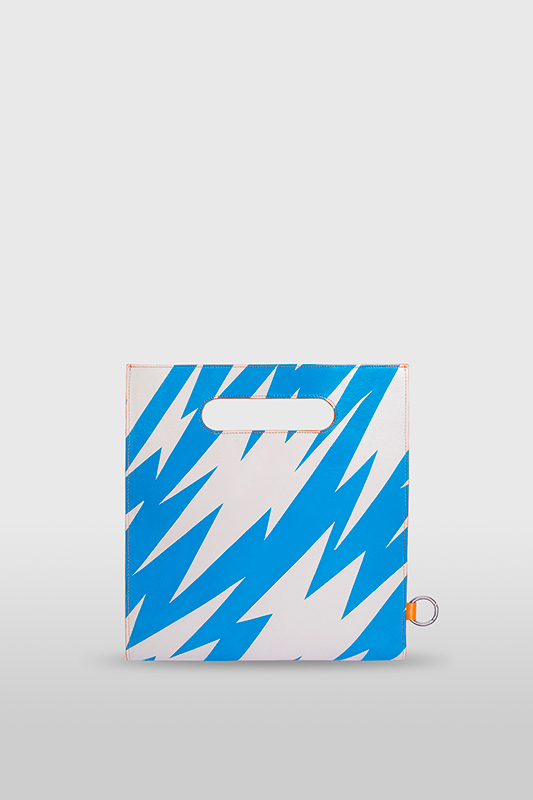



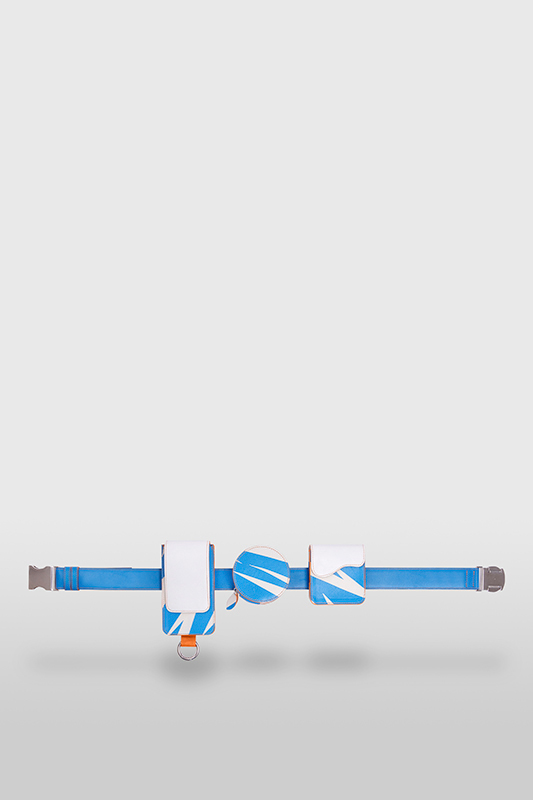

Loretta
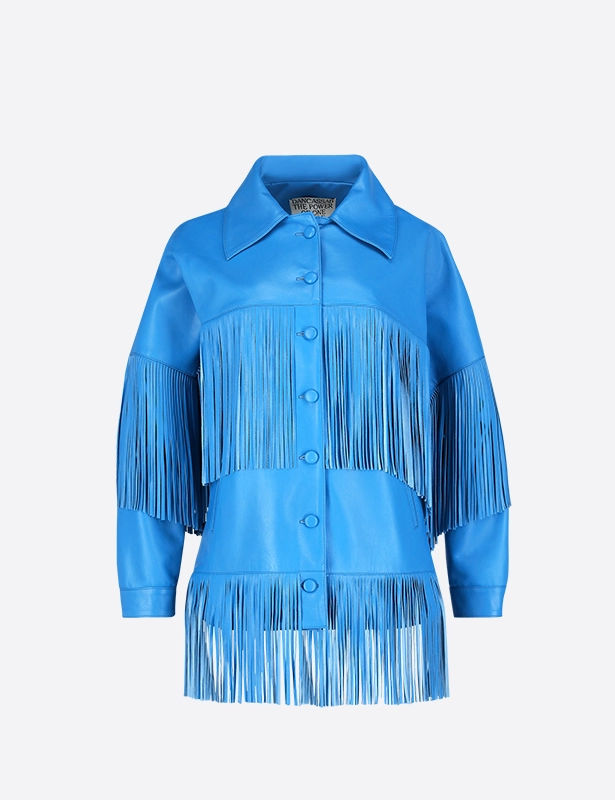
Loretta


